- Nature / Scenery
- History / Culture
- Gourmet
- Experiences
No.f_0034
From the Seto Inland Sea to Harima—Salt, Hishio, and a Story of Fermentation
Cross the calm waters of the Seto Inland Sea and you enter a world shaped by salt and hishio (salt-fermented foodstuffs). In the Edo period (1603–1868), ships laden with salt from Ako called at tide-waiting ports before reaching Shodoshima. There, fine salt met soybeans and wheat; under the island’s warm climate, fermentation took its course, and soy-sauce making on Shodoshima began. On this “island of hishio,” the aroma of koikuchi (dark) soy sauce—brewed in wooden vats and handed down for more than 400 years—still remains to this day.
Later, in Tatsuno, a castle town in Harima, usukuchi (light) soy sauce was created to achieve the delicate hues essential to Kyoto cuisine—light in colour yet rich in umami.
In this way, fermented seasonings that lend Japanese food its depth of aroma and flavor have been nurtured over long years by local climates and artisanal craft. This journey traces the culture of soy sauce and miso born from Hyogo’s quality salt and soybeans, then crosses the Seto Inland Sea to Shodoshima, famed for traditional soy-sauce making. Beyond flavor alone, it invites you to savor Japan’s fermentation culture with all five senses—the taste, the scent, and even the feel by hand.
Tatsuno, Home of Usukuchi Soy Sauce
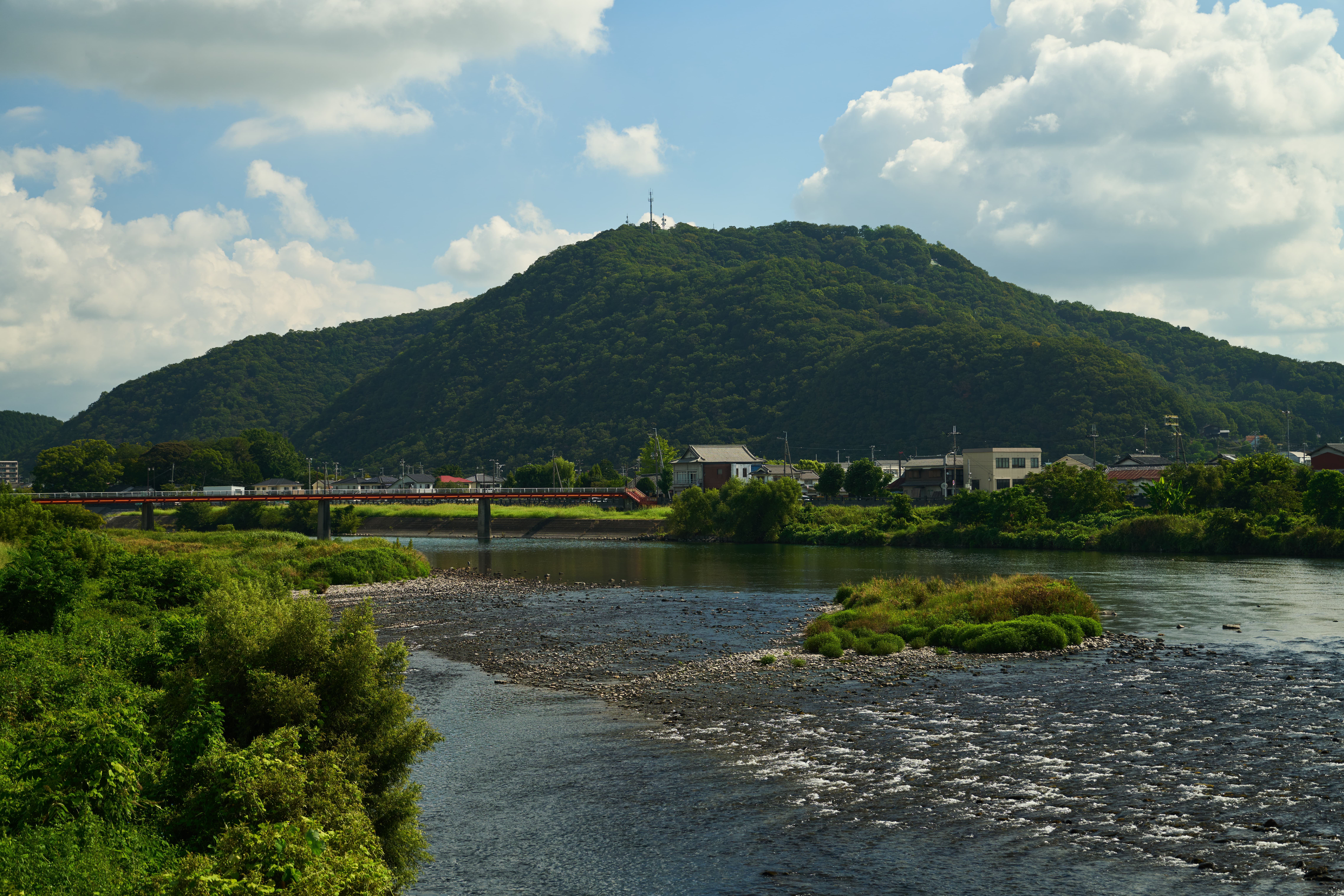 The Ibo River, a Class A river system.
The Ibo River, a Class A river system.
About an hour and a half by car from Kobe Airport, in southwestern Hyogo along the Ibo River that flows through the Banshu Plain, lies Tatsuno, home of usukuchi soy sauce. In 1587, local daimyo encouraged soy-sauce production and developed it into a regional industry. Blessed with fine ingredients—soybeans, wheat, and rice from the Banshu Plain; the Ibo River’s clear water; and Ako salt from the Seto Inland Sea—Tatsuno gave rise to the pale, aromatic usukuchi soy sauce. Thanks to transport routes that used the Ibo River, fresh soy sauce also reached Kyoto and Osaka, centers of advanced food culture, and its reputation spread early on.
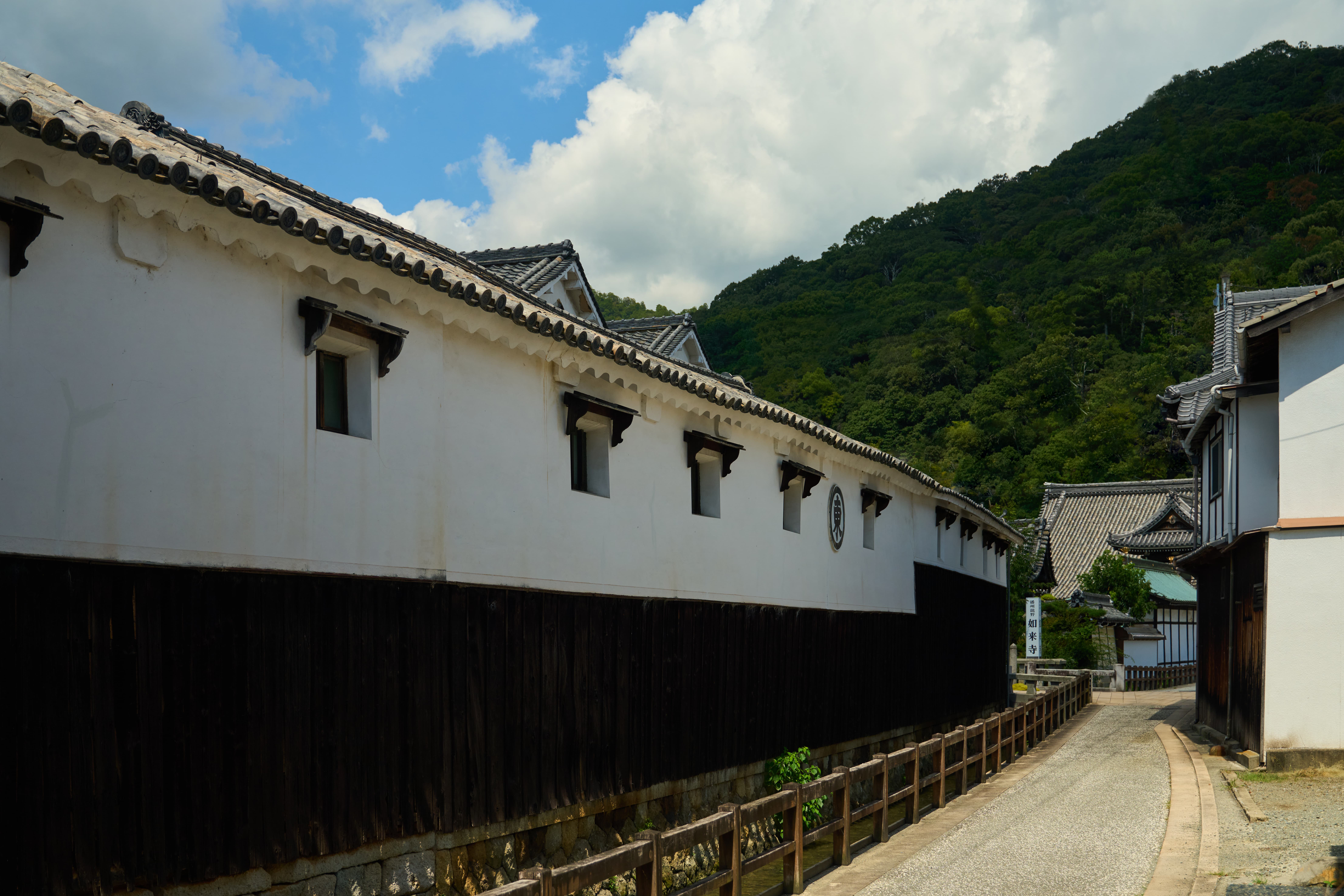
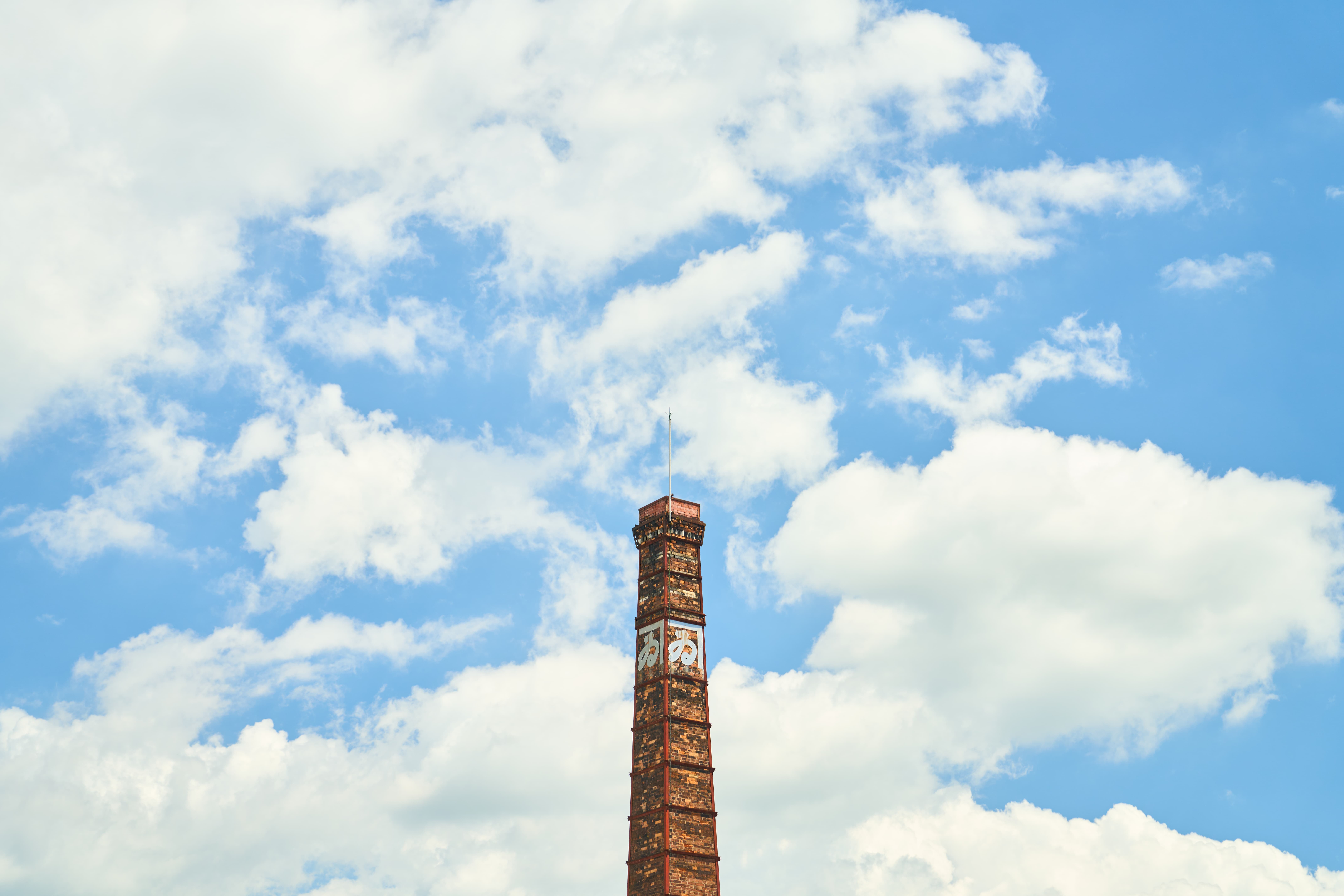 Chimney of a former soy-sauce factory.
Chimney of a former soy-sauce factory.
Lined with long-standing townhouses and soy-sauce storehouses, this district is carefully preserved as the Tatsuno Traditional Buildings Preservation Area. Ad you walk the flagstone streets, a faint soy-sauce aroma wafts from the eaves of white-plastered walls.
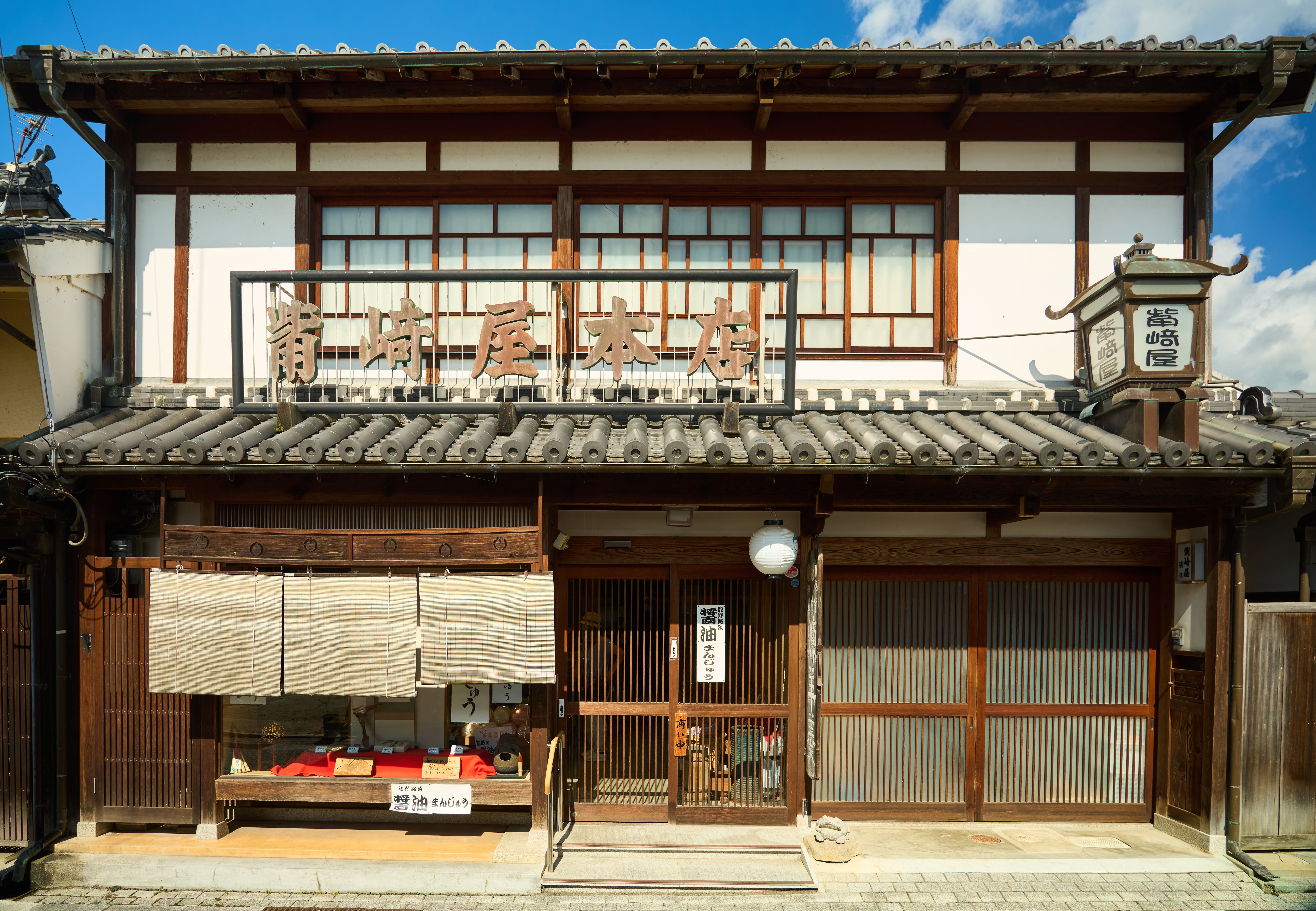 Japanese confectioner Hashisakiya Honten.
Japanese confectioner Hashisakiya Honten.
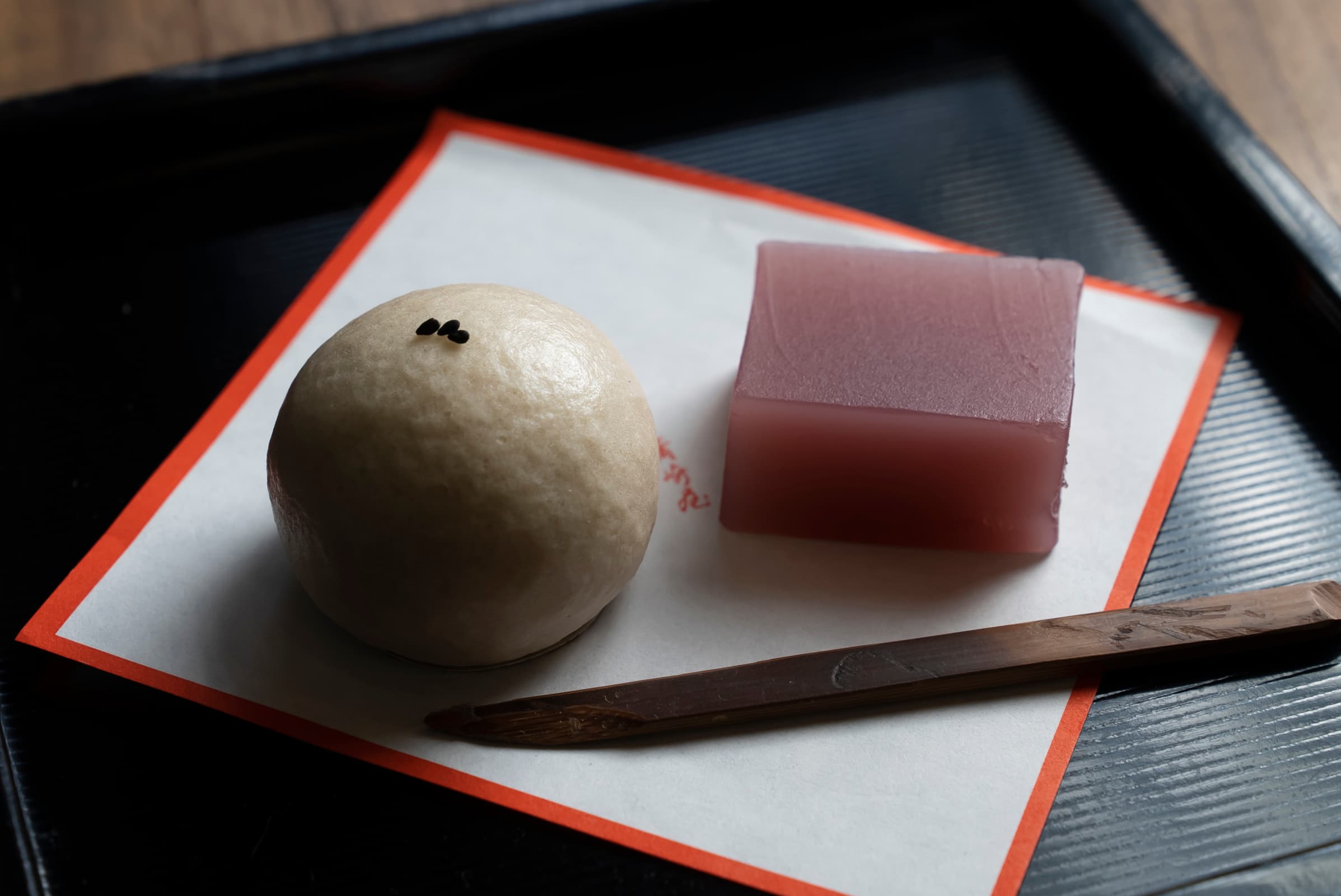 House specialty shoyu manju (soy-sauce sweet bun; left). Beside it is neri yokan (red bean jelly) made with the Hanko cowpea, a rare local bean—an elegant Japanese sweet also recommended for gifts.
House specialty shoyu manju (soy-sauce sweet bun; left). Beside it is neri yokan (red bean jelly) made with the Hanko cowpea, a rare local bean—an elegant Japanese sweet also recommended for gifts.
At the roughly 300-year-old Japanese confectioner Hashisakiya Honten, the signature is shoyu manju. House-made sweet bean paste, cooked from adzuki, is wrapped in a fluffy skin kneaded with Tatsuno’s famed usukuchi soy sauce and then steamed. With a gentle soy-sauce aroma, it’s a popular souvenir.
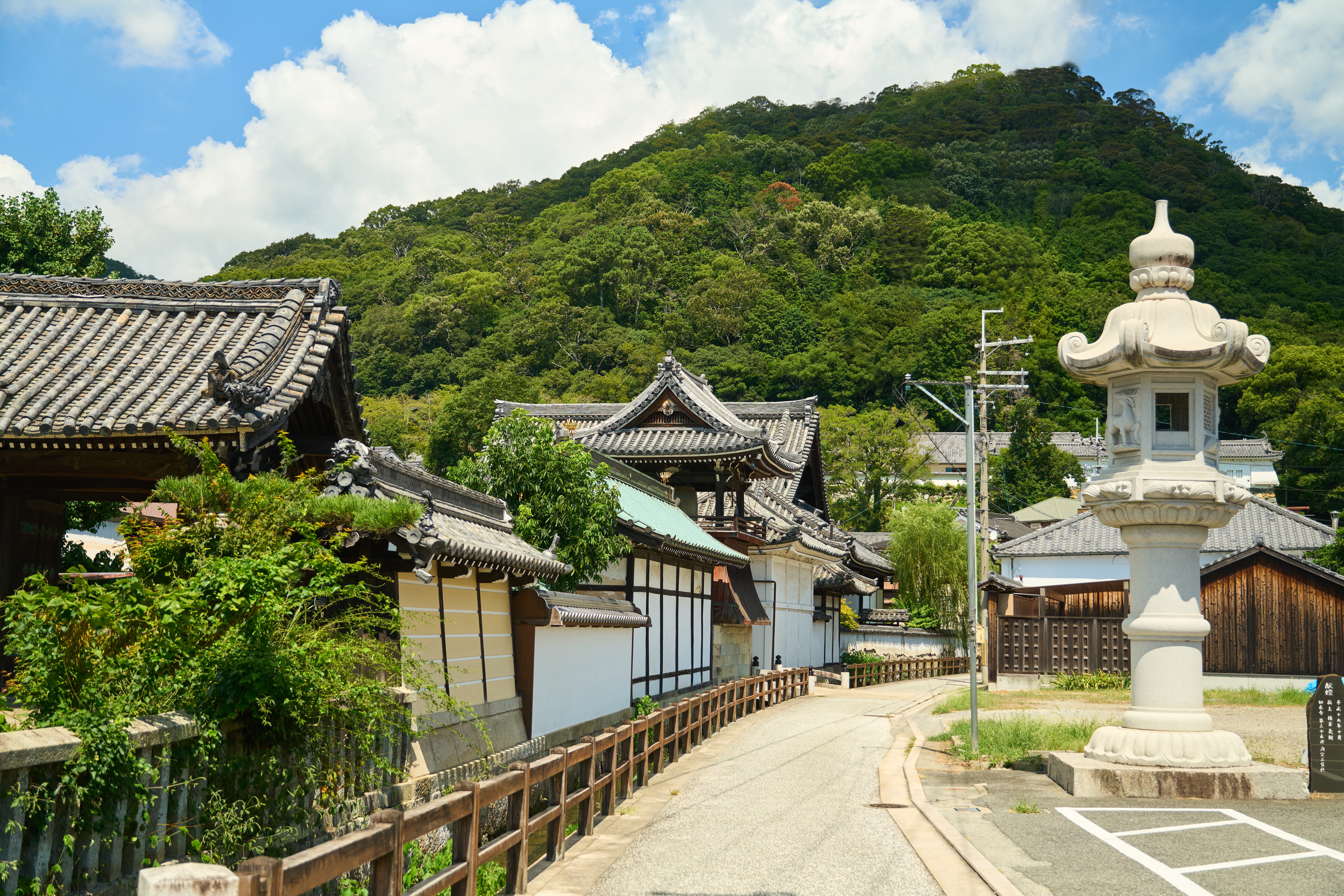
The quiet daily lives of locals who continue to uphold handcraft traditions still breathe in this town.
Experience the World of Soy Sauce with All Five Senses
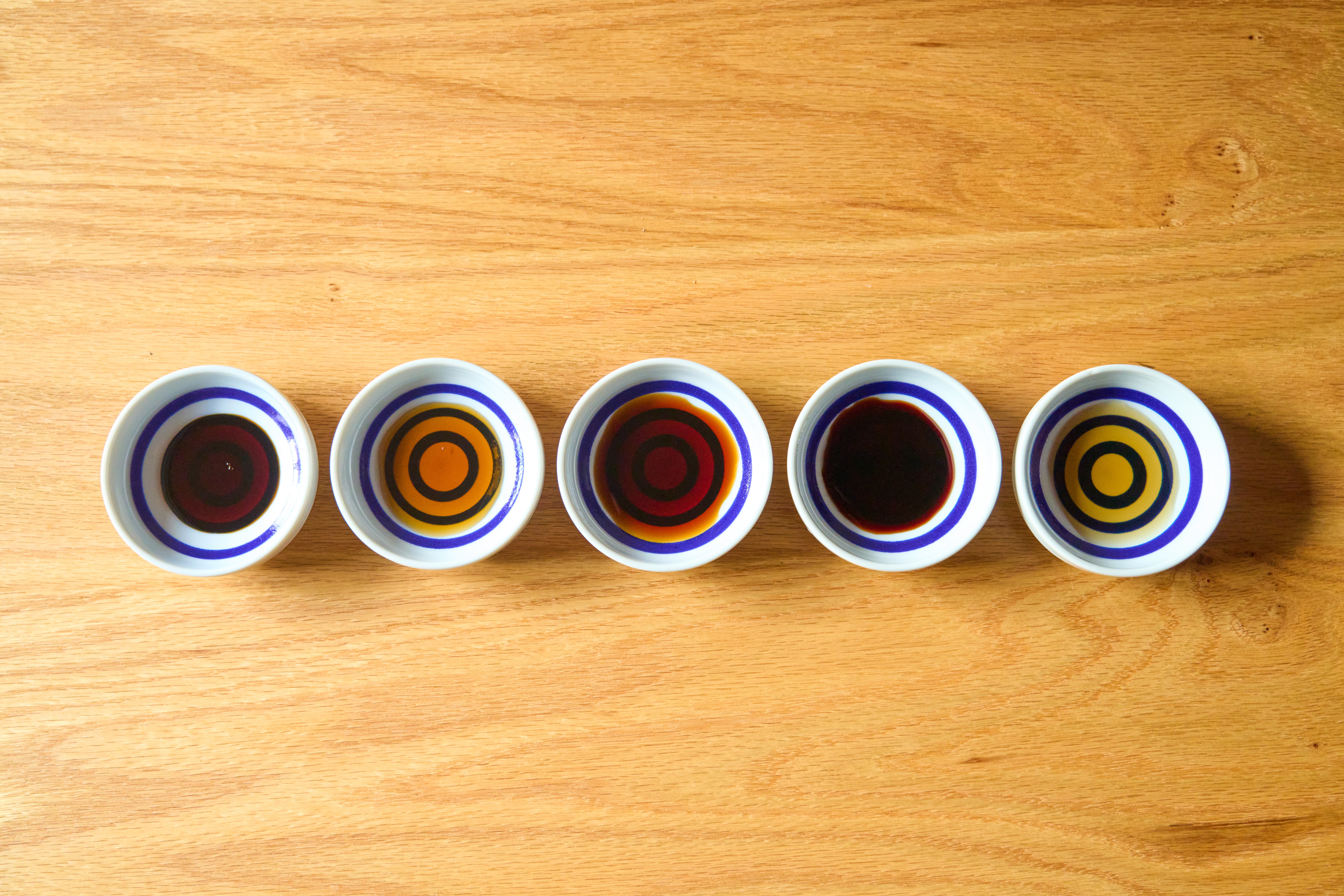 From left: Koikuchi (dark) soy sauce, usukuchi (light) soy sauce, tamari, saishikomi (double-brewed) soy sauce, and shiro (white) soy sauce.
From left: Koikuchi (dark) soy sauce, usukuchi (light) soy sauce, tamari, saishikomi (double-brewed) soy sauce, and shiro (white) soy sauce.
At Hakko Lab Coo, which stands along a street of white-plastered walls, you can take classes that let you experience the world of soy sauce with all five senses.
Soy sauce, which has long underpinned Japanese food culture, is broadly divided into five types. Its quality is strictly managed under JAS (Japan Agricultural Standards), which set criteria such as ingredients, fermentation methods, and salt content. At judging sessions, tasters use janome (snake-eye) motif tasting dishes to carefully assess color, aroma, and flavour.
In Japan, soy sauce is viewed much like wine, with a culture of pairing it to dishes. For example, usukuchi (second from the left) is characterized by its pale color and light aroma. It lets an ingredient’s natural color and flavor shine while gently bringing the whole together—a consummate supporting role. Even in small amounts it draws out the umami of dashi and the saltiness, making it invaluable when you want a refined, lower-salt finish.
By contrast, tamari and saishikomi soy sauces, which have longer ageing periods, are prized for their rich, complex taste. They come into their own with fatty meat dishes and with preparations like teriyaki where depth is desired.
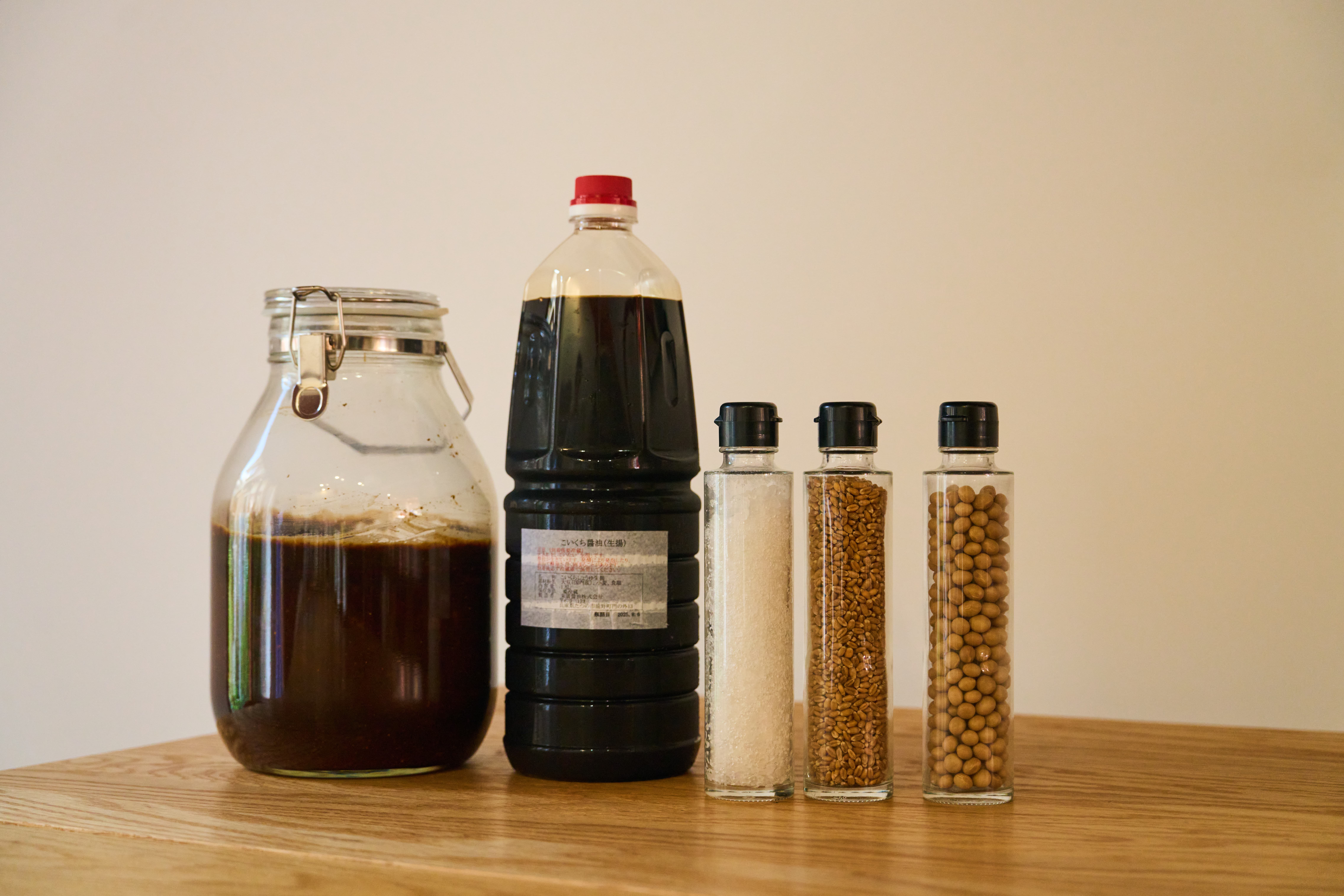 From left: Soy sauce in mid-fermentation; nama shoyu (unpasteurized soy sauce); Ako salt; wheat from the Banshu Plain; soybeans from Nishi-Harima.
From left: Soy sauce in mid-fermentation; nama shoyu (unpasteurized soy sauce); Ako salt; wheat from the Banshu Plain; soybeans from Nishi-Harima.
The usukuchi soy sauce born in Tatsuno is crafted with care from the region’s bounty—soybeans from the Mikazuki area of Nishi-Harima, wheat from the Banshu Plain, Ako salt, and the soft water of the Ibo River—through artisans’ handiwork and long periods of fermentation and maturation.
Create Your One-of-a-Kind “My Shoyu”
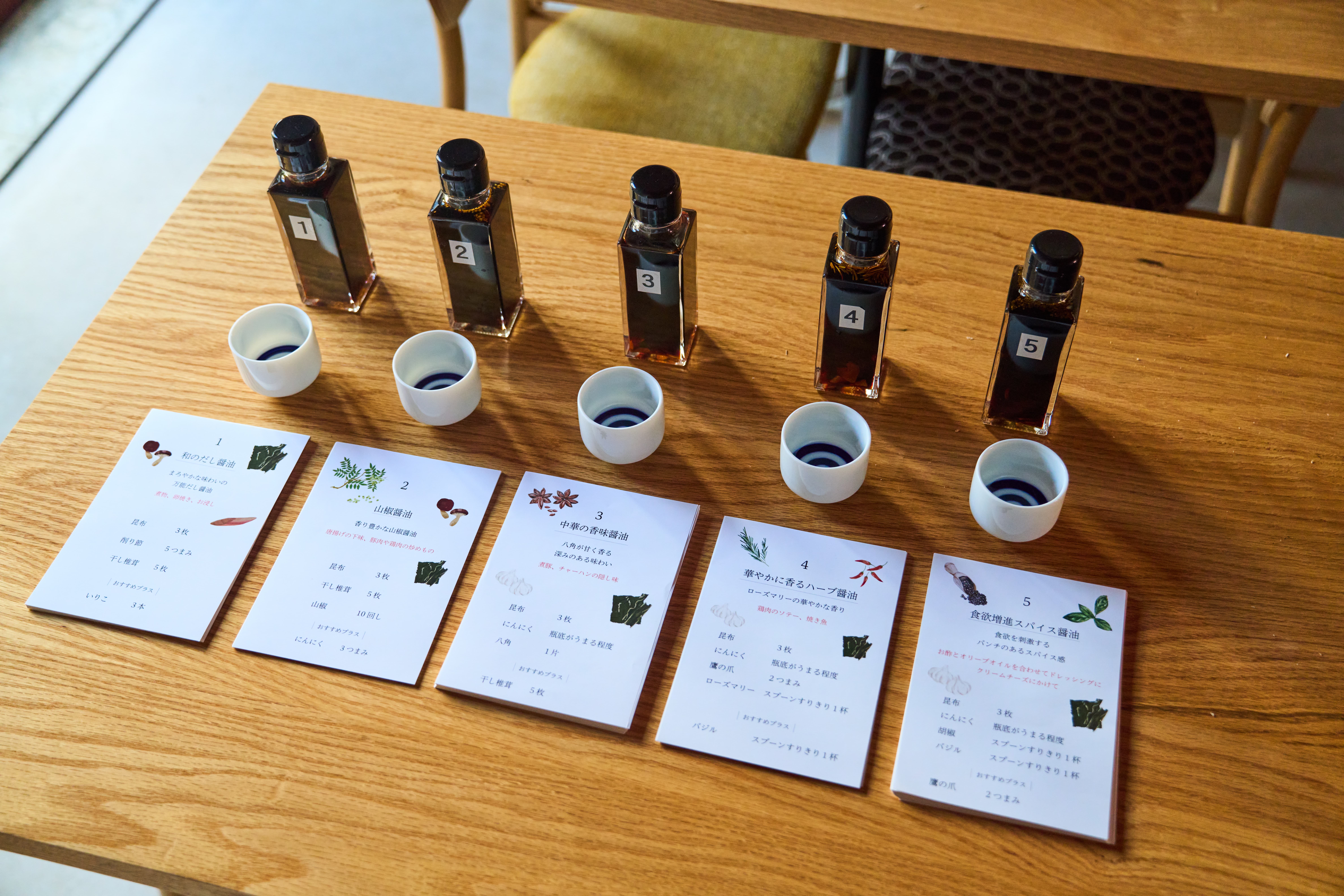
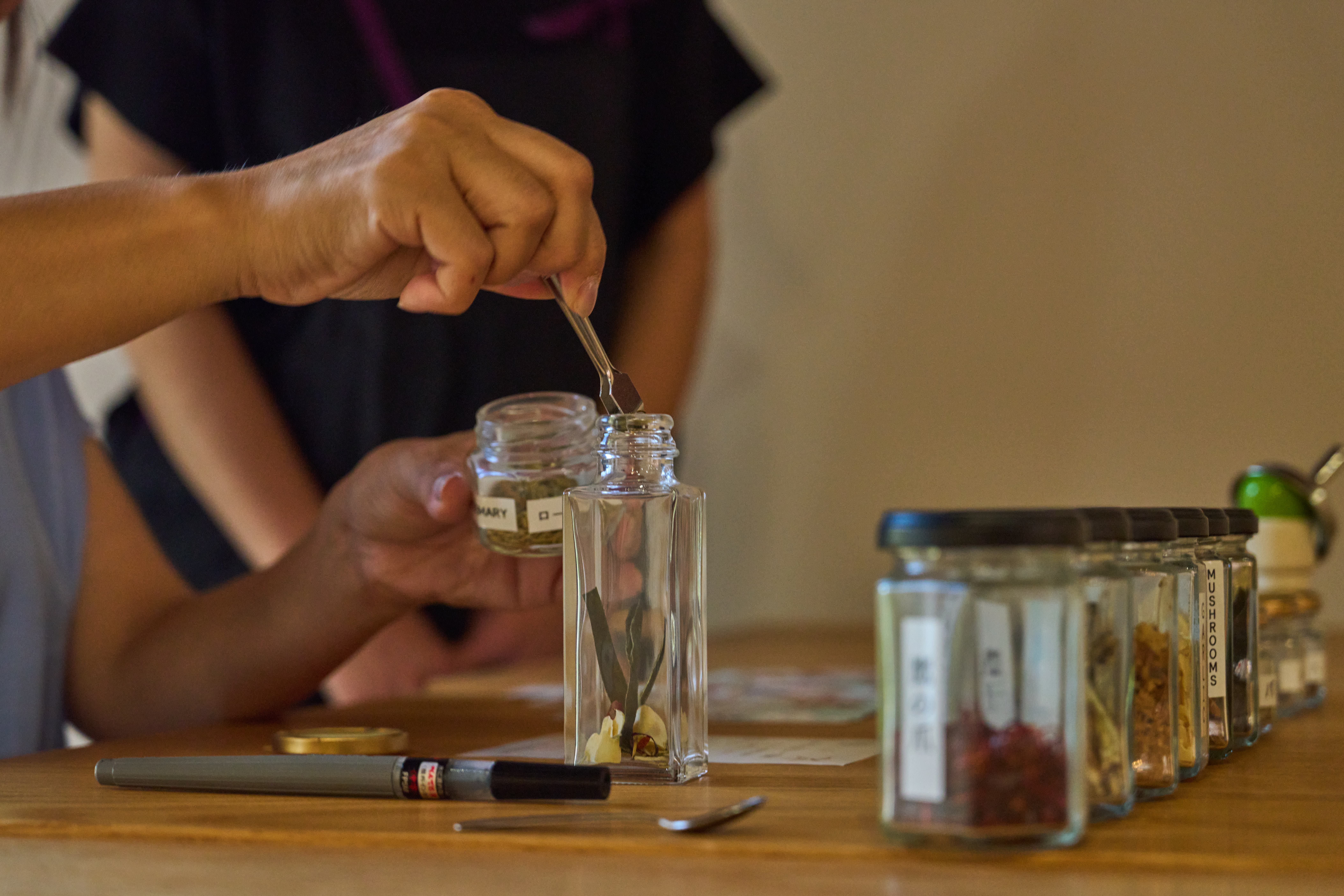 Adding spices to the bottle.
Adding spices to the bottle.
Only in a soy-sauce town can you make your own one-of-a-kind “My Shoyu” using freshly pressed nama shoyu (unpasteurized soy sauce). Choose from five blend types—Wa no Dashi Soy Sauce, Sansho Pepper Soy Sauce, Aromatic Soy Sauce, Herb Soy Sauce, or Spice Soy Sauce. The herb version, popular among women, combines kelp, garlic, red chili, rosemary, and basil.
Adjust the quantities of natural stock and spices to your liking, and as you blend, the fragrance rises vividly.
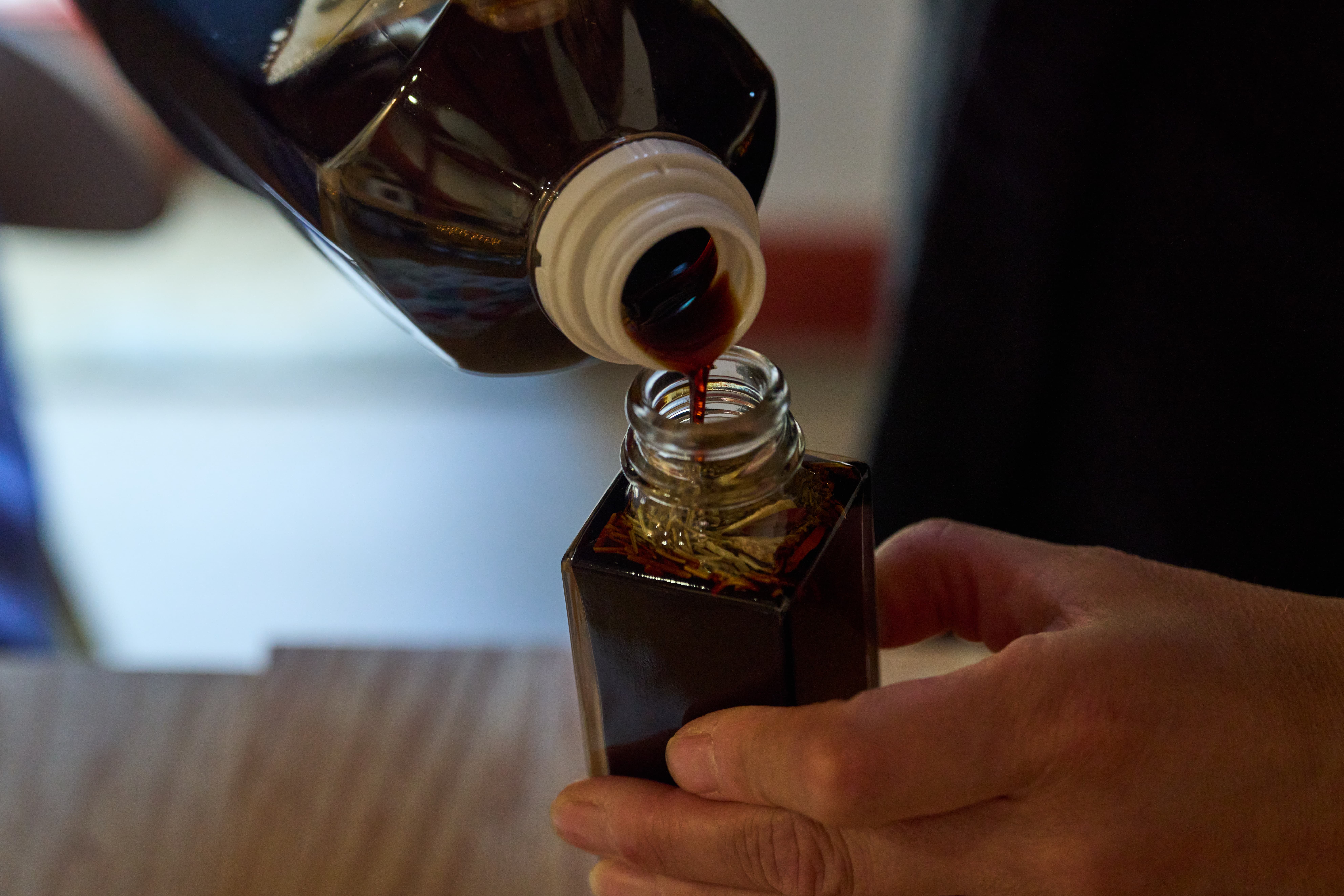 Nama shoyu is filtered but not heat-treated after the moromi fermentation mash is pressed. Rarely distributed commercially, it can be purchased directly from soy-sauce breweries and their on-site shops.
Nama shoyu is filtered but not heat-treated after the moromi fermentation mash is pressed. Rarely distributed commercially, it can be purchased directly from soy-sauce breweries and their on-site shops.

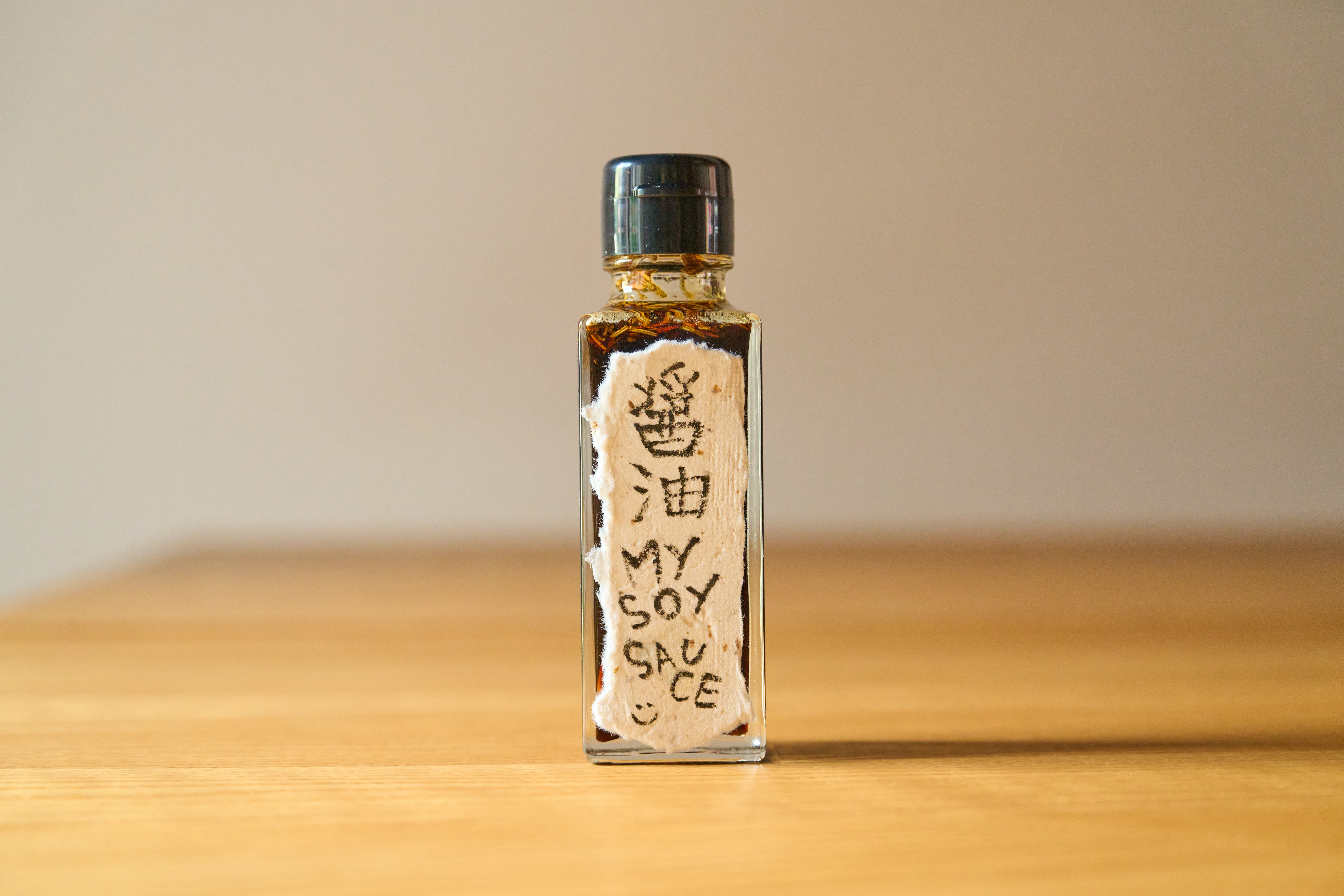 Participation fee: 2,200 yen per person, including one bottle of “My Shoyu.” Reservations by phone or via the official LINE account.
Participation fee: 2,200 yen per person, including one bottle of “My Shoyu.” Reservations by phone or via the official LINE account.
After heating, the bottle is sealed and finished with a Japanese washi paper label handwritten in brush calligraphy. The result is your own My Shoyu—a special experience that engages every sense, from aroma and taste to the joy of creating something uniquely yours.
Making Your Own Flavor: The Miso Ball Experience
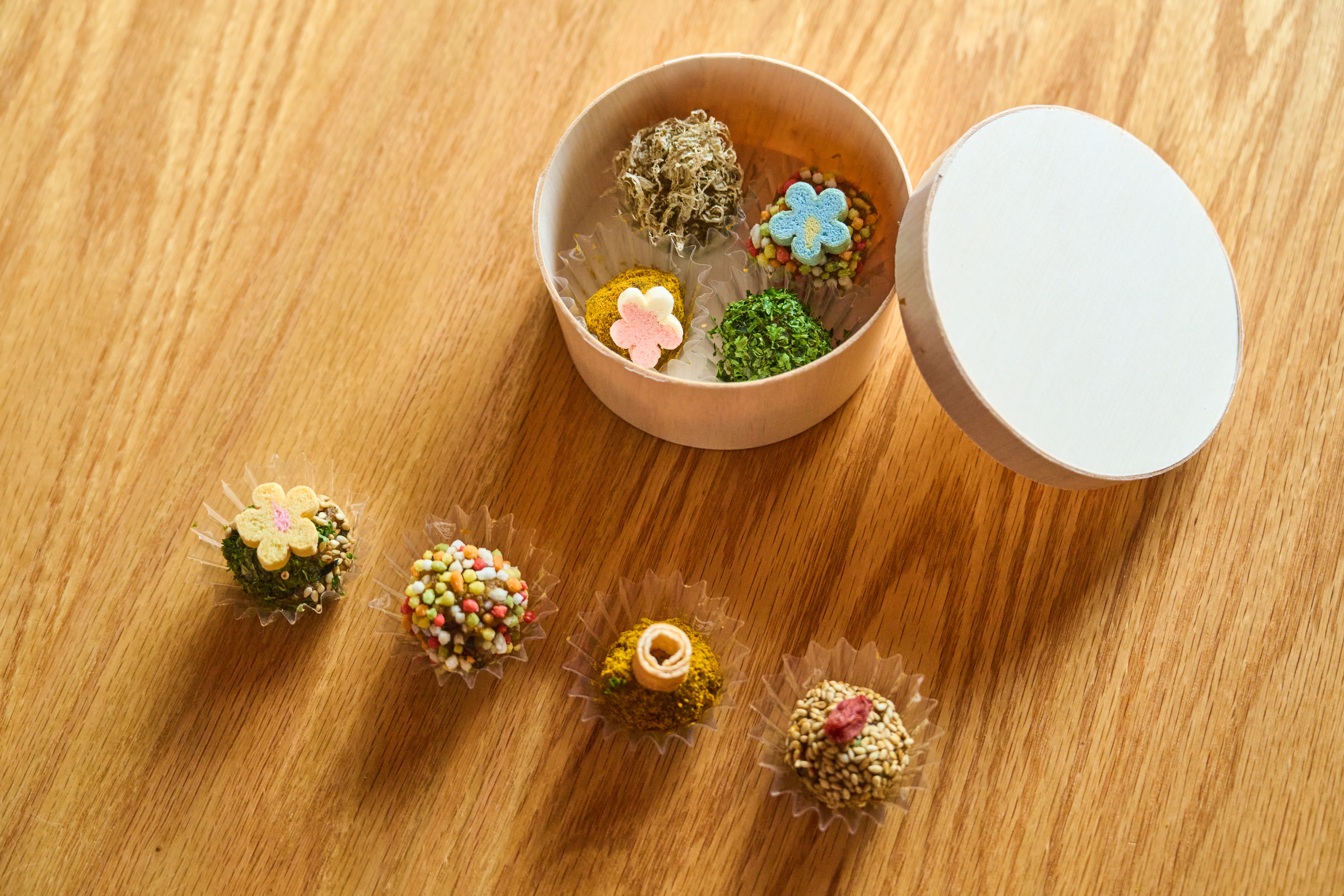 Colorful miso balls are delightful just to look at.
Colorful miso balls are delightful just to look at.
Alongside soy sauce, one of Japan’s essential fermented foods is miso. When miso is mixed with dried bonito flakes, stock, and other ingredients and rolled into single portions, it becomes a miso-dama, or miso ball. Simply pour in hot water to enjoy instant miso soup—a handy, creative idea that brings tradition into daily life.
At Hakko Lab Coo, programs go beyond soy sauce to share Japan’s proud fermentation culture more broadly, including classes on koji, miso, and amazake (sweet fermented rice beverage) making. One of the most popular is the miso-dama workshop. Not only are the colorful balls adorable, but because they can be turned into delicious soup just by adding hot water, the program is especially loved by younger women.
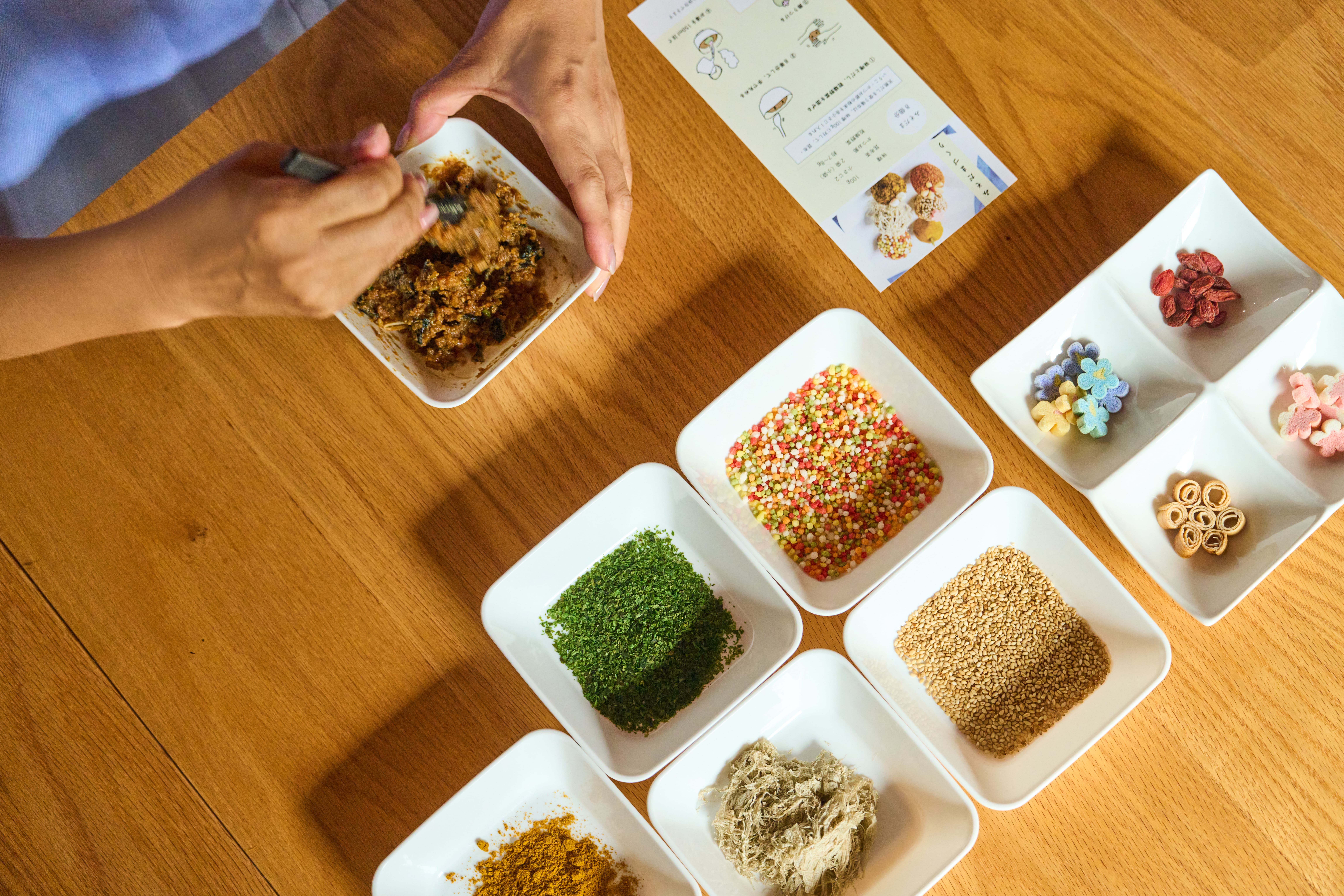 Toppings include aonori dried seaweed, sesame, fried tofu, tororo kelp, and curry powder.
Toppings include aonori dried seaweed, sesame, fried tofu, tororo kelp, and curry powder.
Add natural dried vegetables and your choice of toppings to Banshu miso—rich in koji—and your original miso-dama is complete.
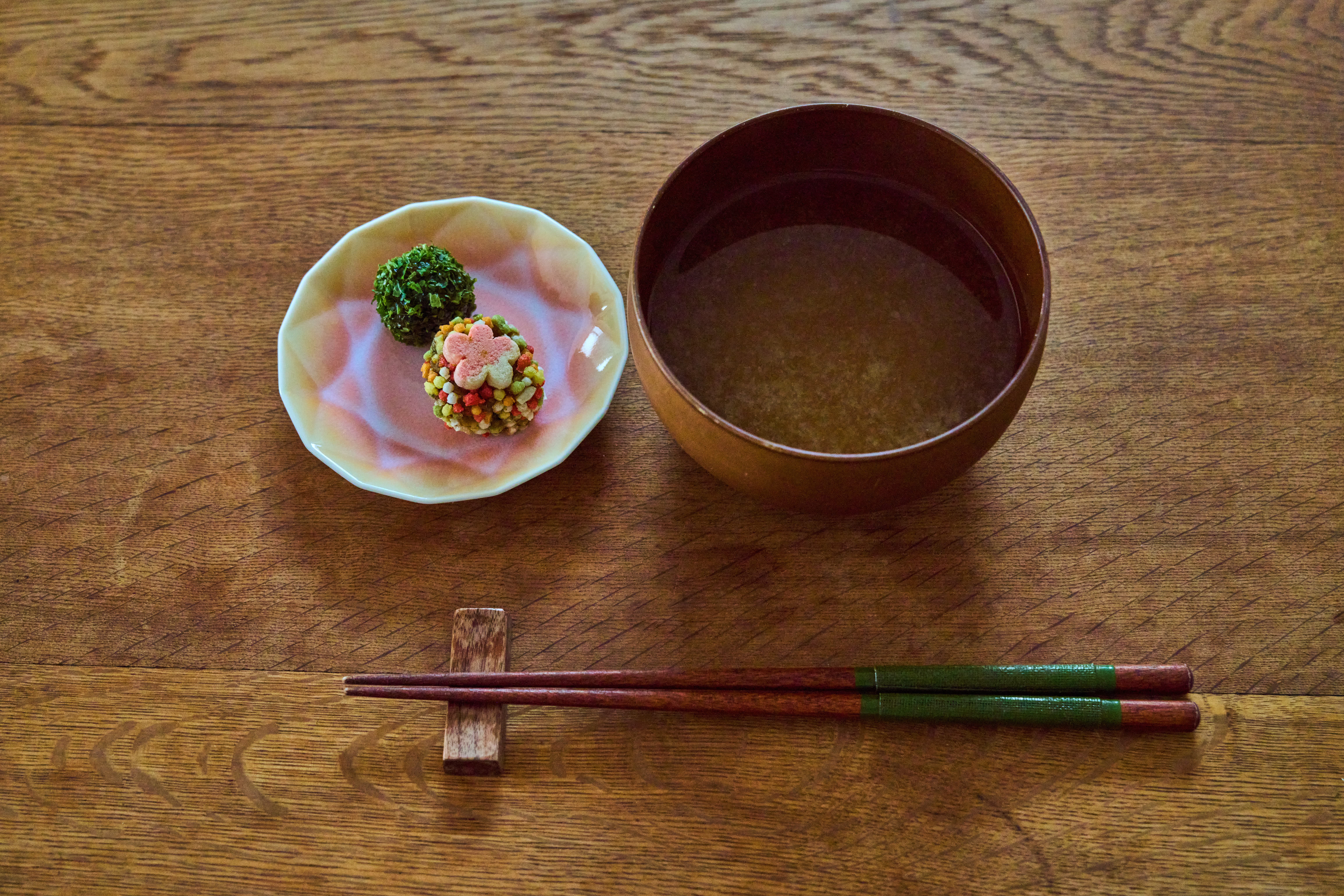 One ball makes a single serving of miso soup; enjoy the different aromas depending on your chosen toppings.
One ball makes a single serving of miso soup; enjoy the different aromas depending on your chosen toppings.
For Japanese people, miso soup is soul food—an indispensable part of daily life and a mirror of regional food culture, adapting to the local ingredients of each season. Miso-dama condenses that wisdom and flavor into a convenient, long-lasting form. Through the miso-dama workshop at Hakko Lab Coo, visitors can experience Japan’s culinary traditions firsthand.
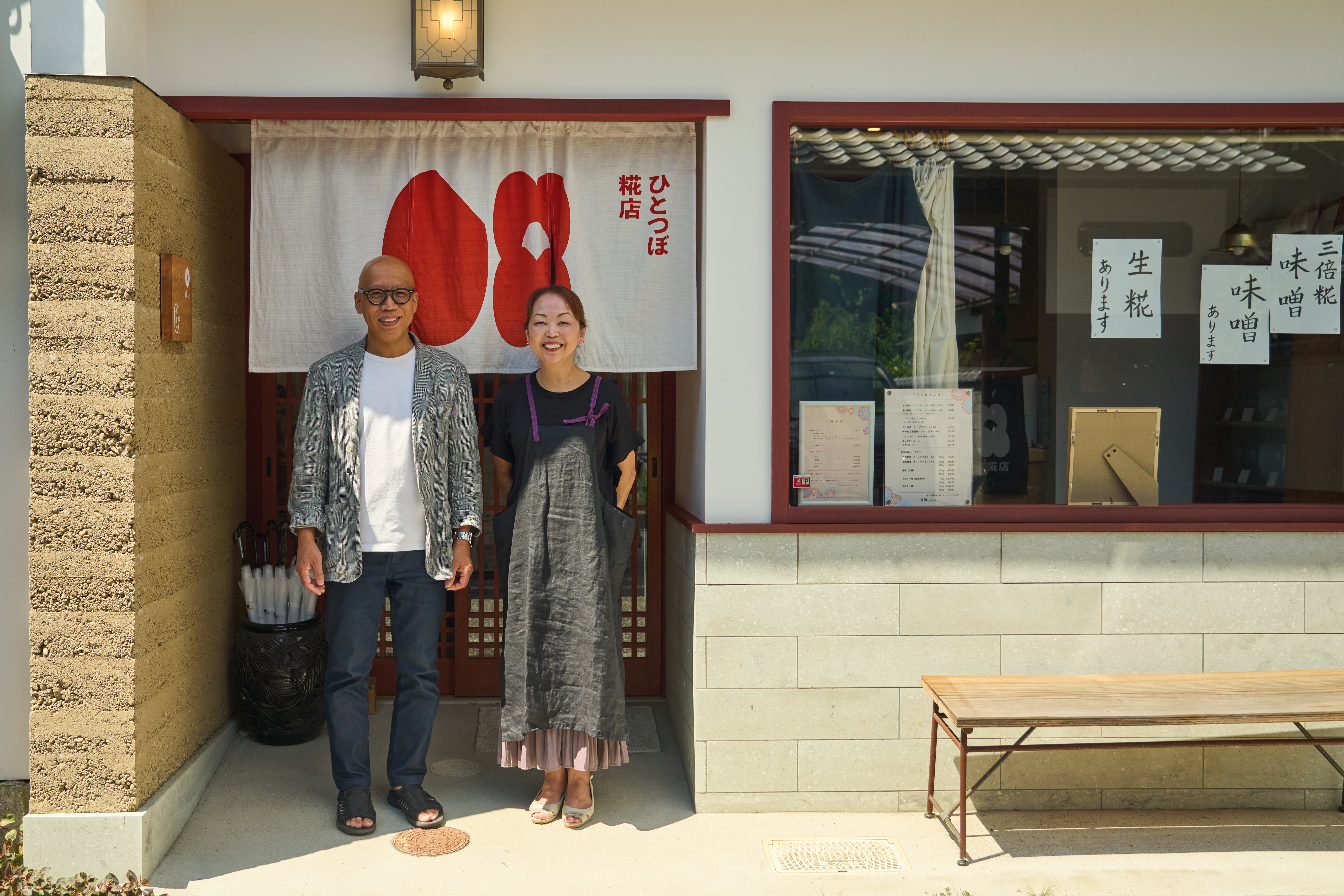 Nutritionist Miyuki Matsushita and her husband Hiroaki, an agricultural scientist who researches fermentation and soy sauce, serve as fermentation instructors.
Nutritionist Miyuki Matsushita and her husband Hiroaki, an agricultural scientist who researches fermentation and soy sauce, serve as fermentation instructors.
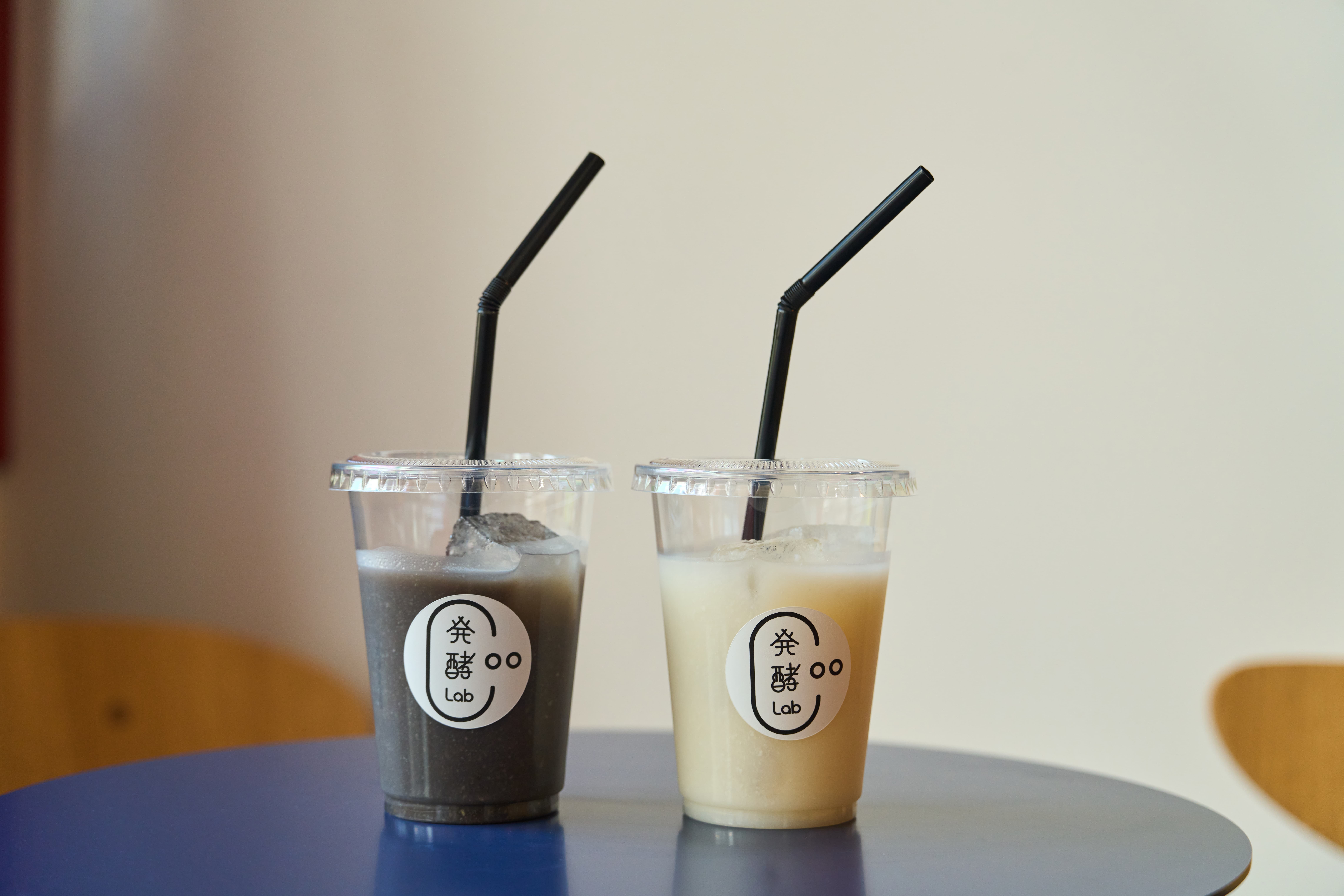 House-made koji amazake: black and white varieties, both 500 yen (tax included).
House-made koji amazake: black and white varieties, both 500 yen (tax included).
Run by the couple, the fermentation classroom also has an adjoining café where visitors can relax and enjoy handmade fermented foods and amazake at leisure.
BOOK YOUR STAY IN TATSUNO
Visit a Brewery Using Some of Japan’s Largest Wooden Vats
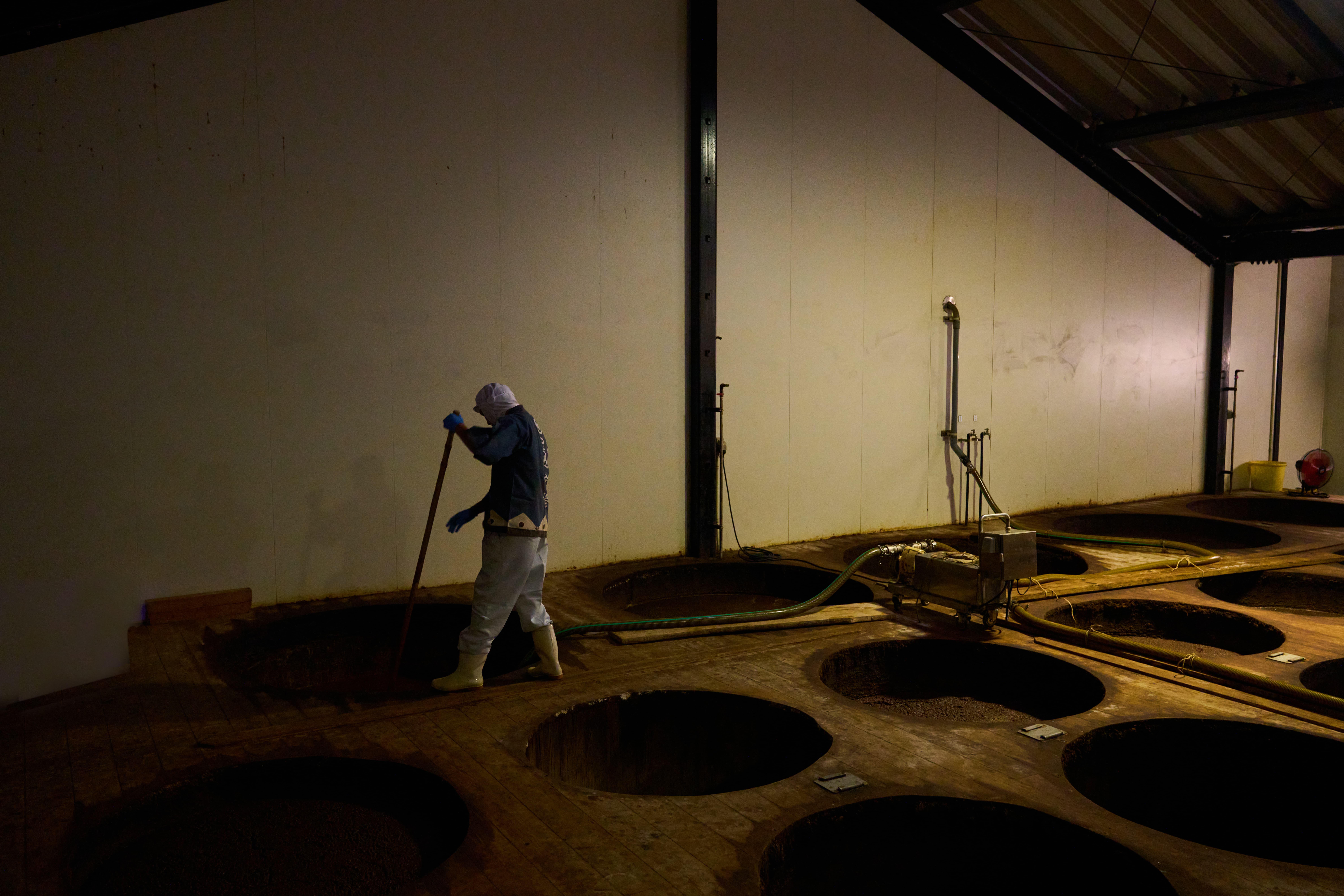
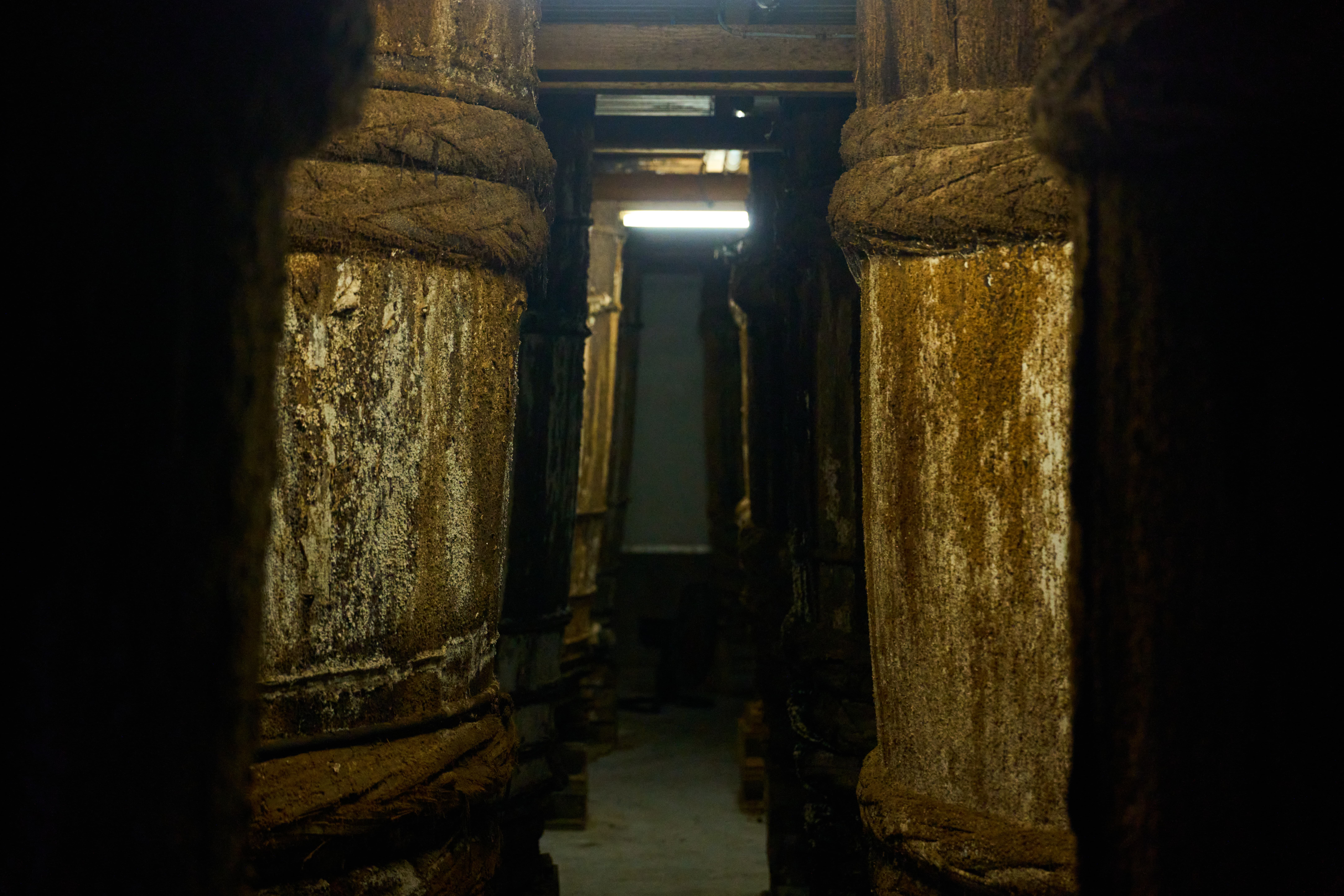 Aged Yoshino cedar vats used for fermentation.
Aged Yoshino cedar vats used for fermentation.
About an hour’s drive north from Tatsuno, in the countryside of Taka Town surrounded by mountains, stands Adachi Brewery, founded in 1889. Since its founding, the brewery has upheld the tradition of wooden-vat brewing. Craftspeople carefully stir the moromi fermentation mash up to three times a week, observing the fermentation process. The soy sauce, matured for more than a year in vats that have been used for over a century, takes on the brewery’s unique aroma and deep umami created by resident lactic acid and yeast cultures—resulting in Adachi Brewery’s distinct flavor.
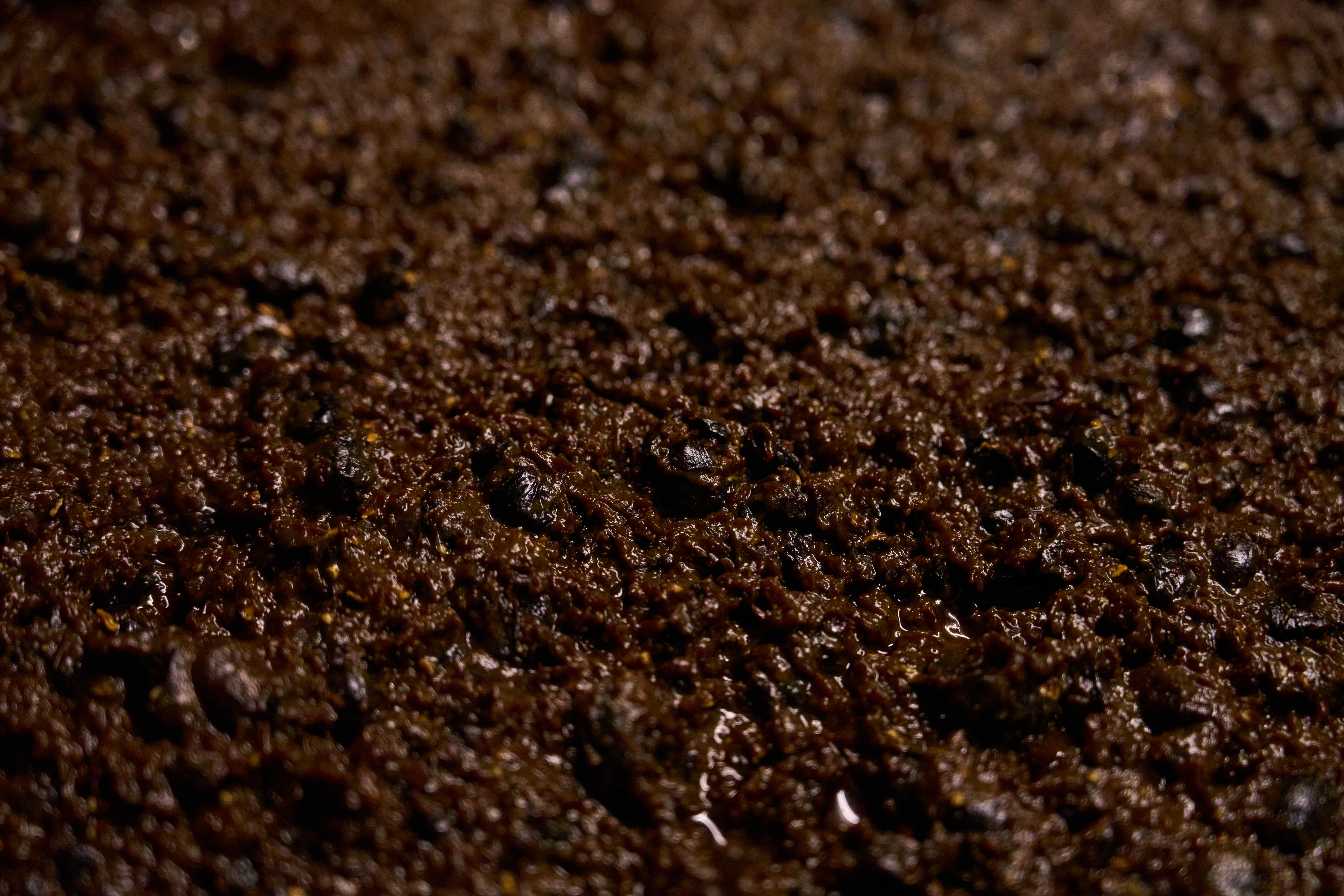 Luxuriously brewed with black soybeans from Tamba-Sasayama.
Luxuriously brewed with black soybeans from Tamba-Sasayama.
Adachi Brewery primarily uses domestically sourced ingredients certified under Japan’s Organic JAS standards. By avoiding additives and brewing slowly in wooden vats using traditional methods, they produce safe, reliable soy sauce. The results include mellow organic varieties and richly flavored brews made with black soybeans from Tamba-Sasayama—distinctive tastes shaped by Hyogo’s land itself. Experiencing these robust flavors alongside Tatsuno’s light usukuchi soy sauce reveals how each region’s climate is reflected in its soy sauce.
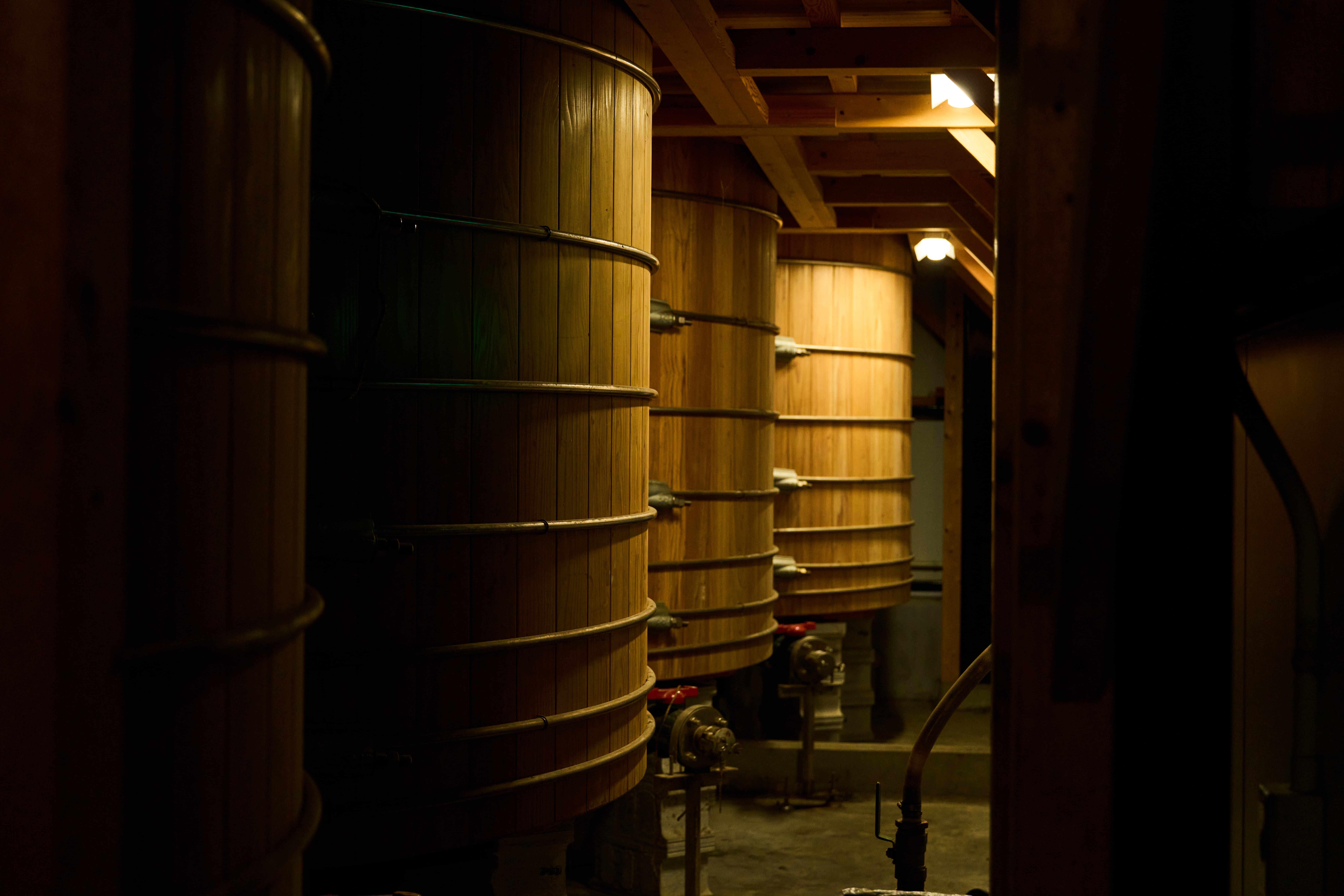 In 2018, four new wooden vats were built, each holding about 5,000 liters. Focusing on domestically grown organic ingredients, the soy sauce ferments and matures naturally for over a year.
In 2018, four new wooden vats were built, each holding about 5,000 liters. Focusing on domestically grown organic ingredients, the soy sauce ferments and matures naturally for over a year.
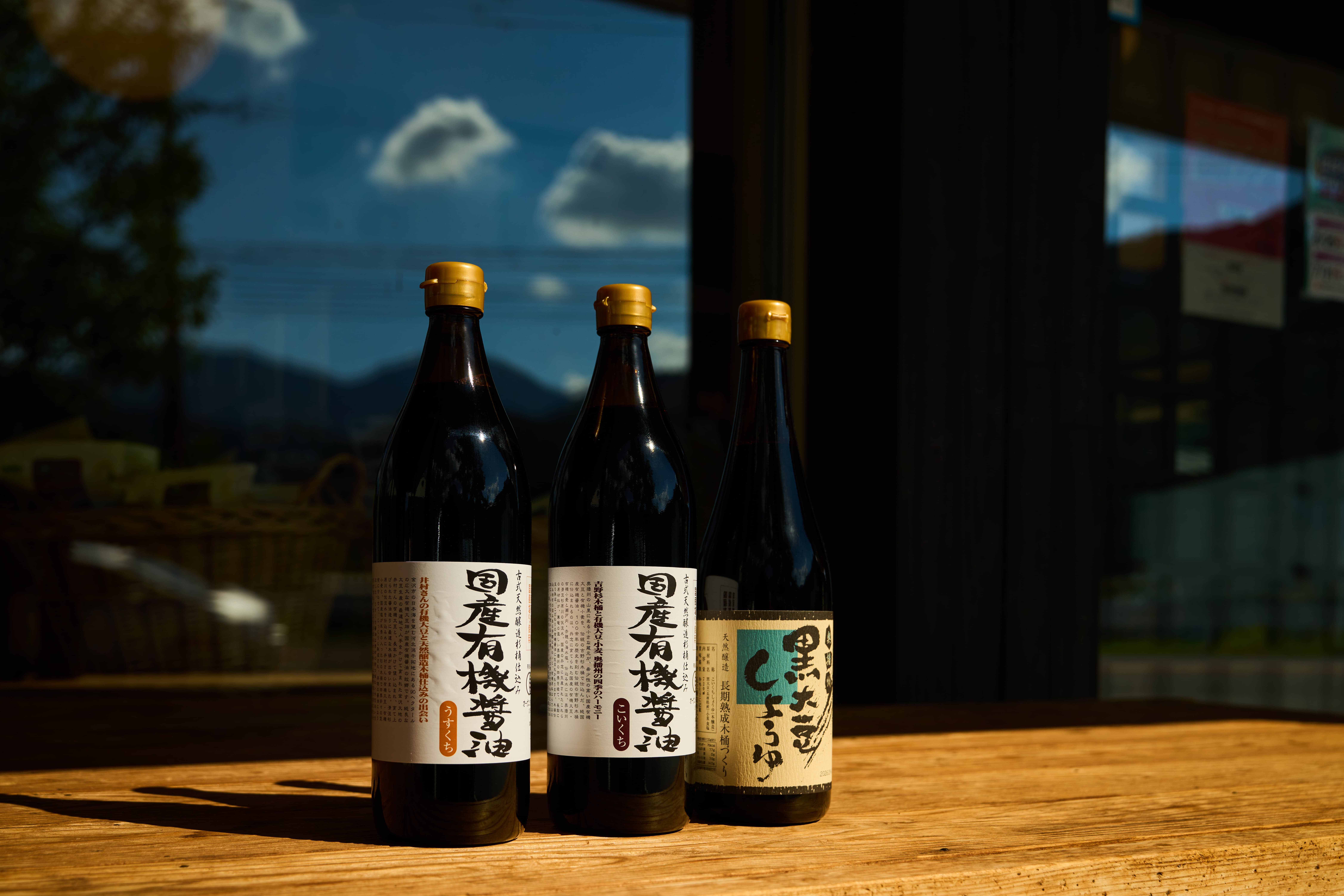 100% organic JAS-certified soy sauce brewed with ingredients grown by contract farmers.
100% organic JAS-certified soy sauce brewed with ingredients grown by contract farmers.
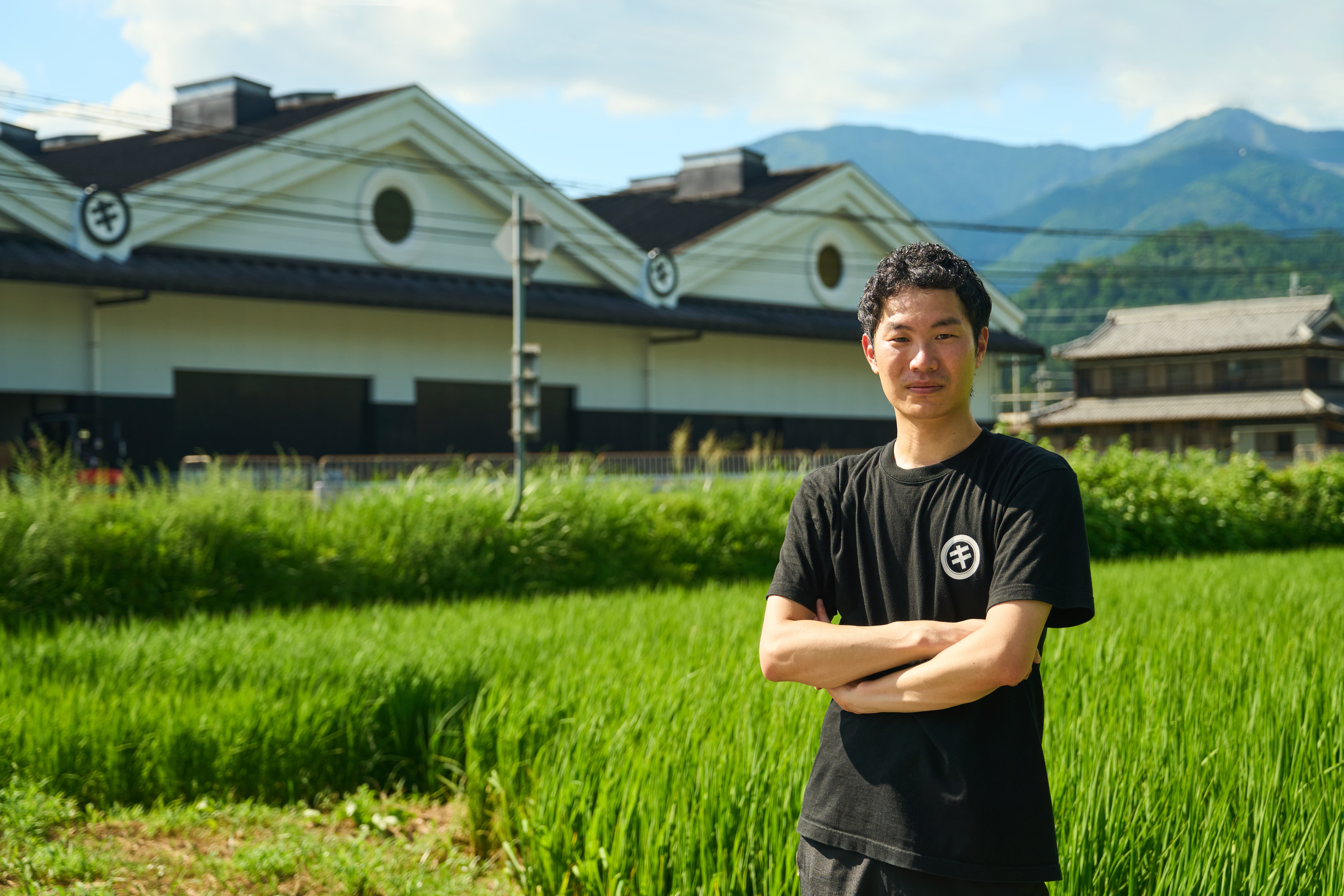 Manabu Adachi, who left a career in advertising to continue the family tradition.
Manabu Adachi, who left a career in advertising to continue the family tradition.
The large new vats installed in one corner of the brewery were hand-assembled by artisans in 2012, reflecting the brewery’s commitment to producing all its soy sauce in wooden vats. This once-rare traditional method now underpins the brewery’s refined modern form, guided by fifth-generation owner Manabu Adachi and his brother Yutaka. “We actively welcome young artisans and want to keep challenging ourselves with new ideas,” says Manabu. The air inside the brewery—rich with the fragrance of long-cultivated fermentation and overflowing with the brothers’ shared passion—conveys both the depth of Hyogo’s fermentation culture and its hopeful future to all who visit.
BOOK YOUR STAY IN TAKA
Shodoshima: An Island of Soy Sauce Born from Ako’s Blessing

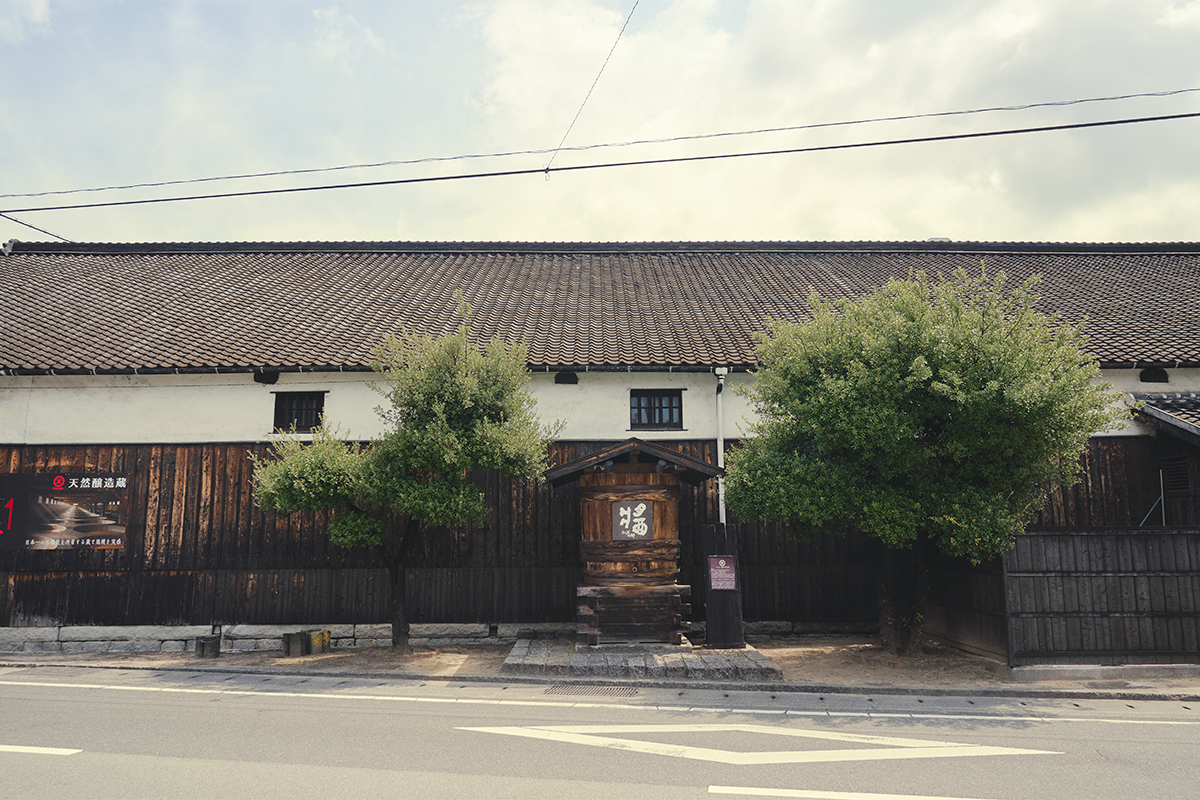
Board the ferry from Himeji Port and cross the calm waters of the Seto Inland Sea for about 1 hour 40 minutes. From the deck, you can see the scattered islands of the Ieshima archipelago, while seagulls occasionally glide alongside—stirring a sense of travel and anticipation.
Soon the island of olives and soy sauce, Shodoshima, comes into view. As the ferry approaches the port, rows of white-walled buildings and verdant mountains rise to greet you.
In the Edo period, ships carrying fine salt from Ako sailed through tide-waiting ports on the Seto Inland Sea before arriving at Shodoshima. Blessed with a warm climate and pure water, the island combined Ako salt with soybeans and wheat, giving birth to soy-sauce making.
With more than 400 years of history, Shodoshima’s soy sauce is still brewed in cedar vats, developing rich umami and aroma over time. Along the island’s streets, soy-sauce storehouses lined with wooden vats form a distinctive landscape known as Hishio-no-Sato, the “home of hishio.”
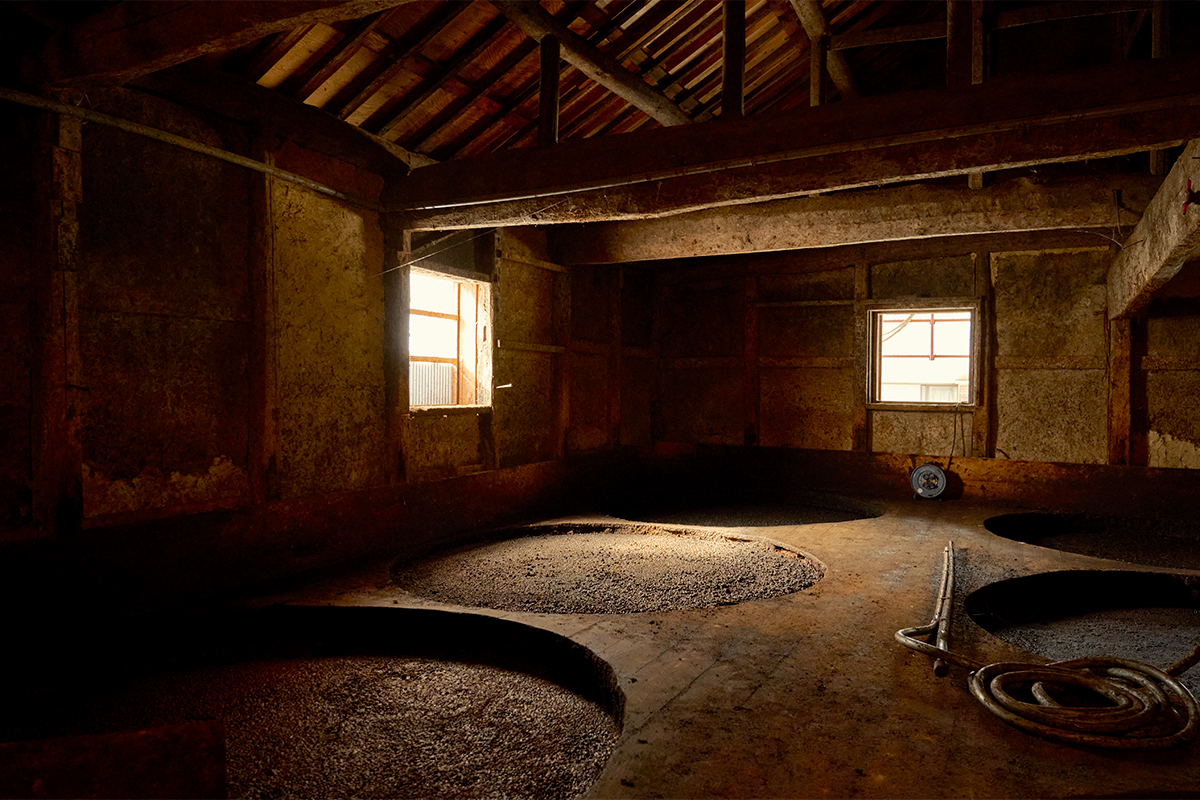 The Yamaroku Shoyu brewery, open for visits, was built in the early Meiji period (1868–1912). Over a hundred strains of yeast and lactic-acid bacteria live within, continuing fermentation and nurturing flavorful moromi fermentation mash.
The Yamaroku Shoyu brewery, open for visits, was built in the early Meiji period (1868–1912). Over a hundred strains of yeast and lactic-acid bacteria live within, continuing fermentation and nurturing flavorful moromi fermentation mash.
Many breweries on Shodoshima still use wooden vats, long considered the finest brewing vessels. Yet today, vat brewing accounts for less than one percent of Japan’s total soy-sauce production. At Yamaroku Shoyu, a brewery with nearly 150 years of history, the team has taken on a project to revive the craft of vat making itself, training under Japan’s last remaining okeya (barrel maker) to pass on authentic soy sauce to the future.
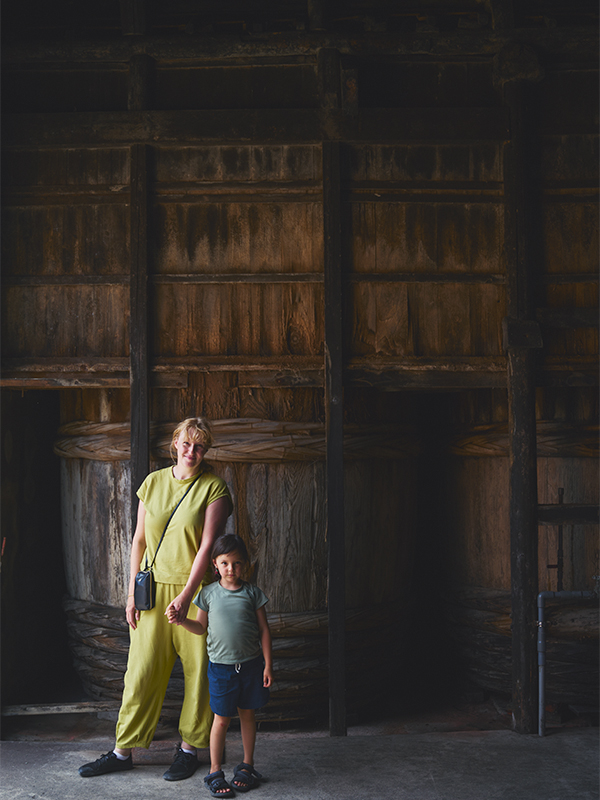
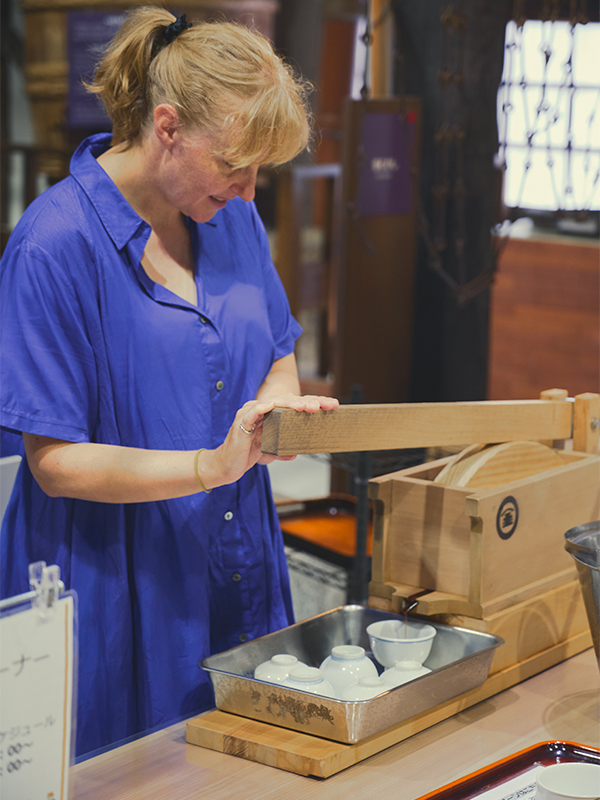
Above: Dropping by a brewery in Hishio-no-Sato. Below: Trying moromi pressing at the Marukin Soy Sauce Kinenkan.
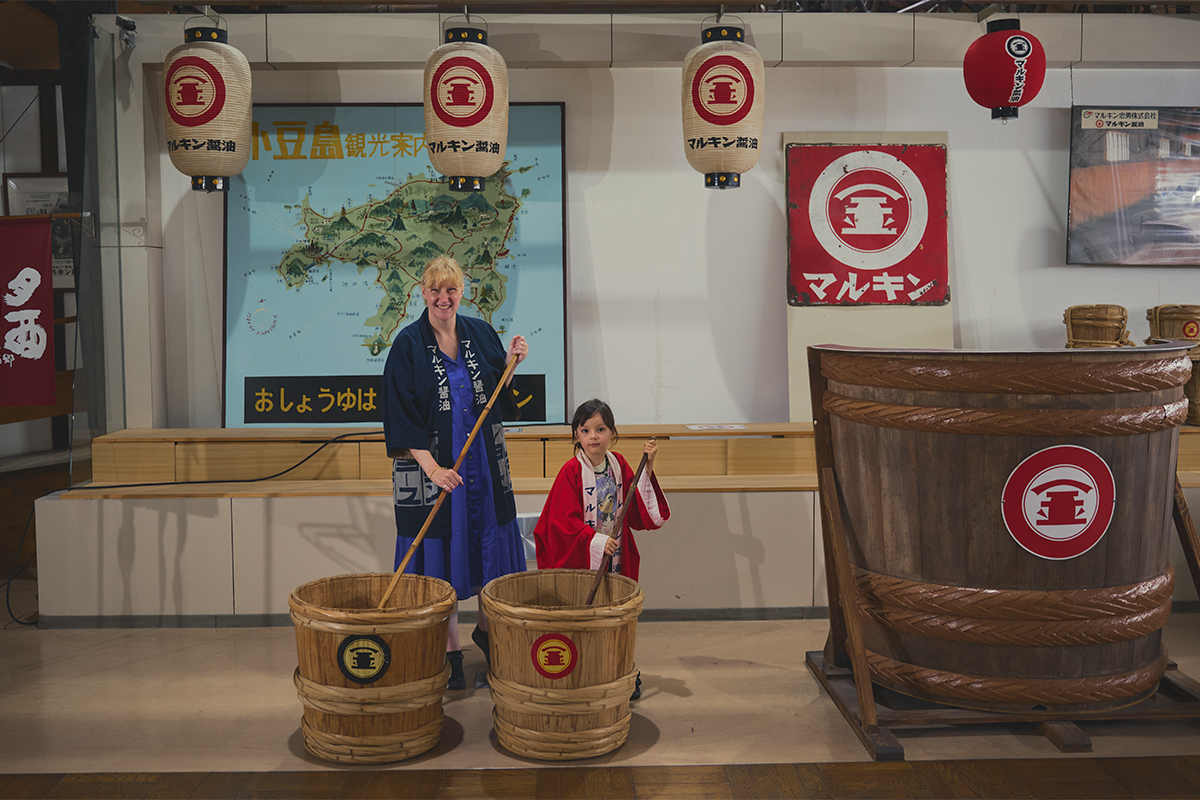 Taking a commemorative photo at the Marukin Soy Sauce Kinenkan.
Taking a commemorative photo at the Marukin Soy Sauce Kinenkan.
In 1987, to mark its 80th anniversary, Marukin Soy Sauce renovated one of Japan’s largest gassho-style buildings—a steeply thatched structure now designated a Registered Tangible Cultural Property—and opened it to the public as a museum.
Exhibits and vintage tools clearly explain the history and production methods of soy sauce.
Enjoy Sake from the Island of Fermentation
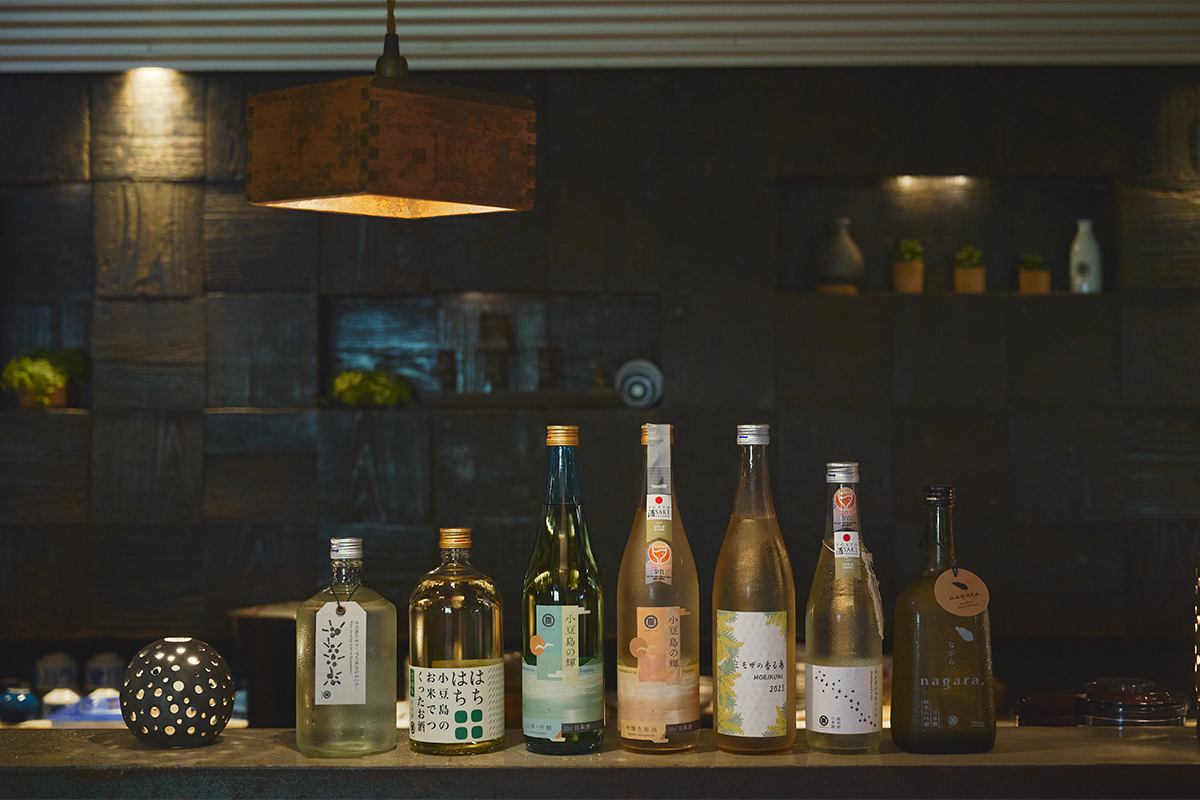 Lightly filtered sake retains its individuality, displaying a soft amber hue straight from pressing.
Lightly filtered sake retains its individuality, displaying a soft amber hue straight from pressing.
On Shodoshima—often called “the island of fermentation”—a must-visit spot is Shodoshima Shuzo MORIKUNI, the island’s only sake brewery. Established in 2015, it revived local sake production for the first time in 35 years.
Its signature sake is brewed using Sanuki Olive Yeast, cultivated from the island’s own olives. The result is a sake with fruity aroma and tropical acidity that has drawn attention from enthusiasts in Japan and abroad.
The brewery’s toji (master brewer) hails from the Tajima region of Hyogo, bringing long experience while adapting traditional kanzukuri winter-brewing techniques to Shodoshima’s warm climate.
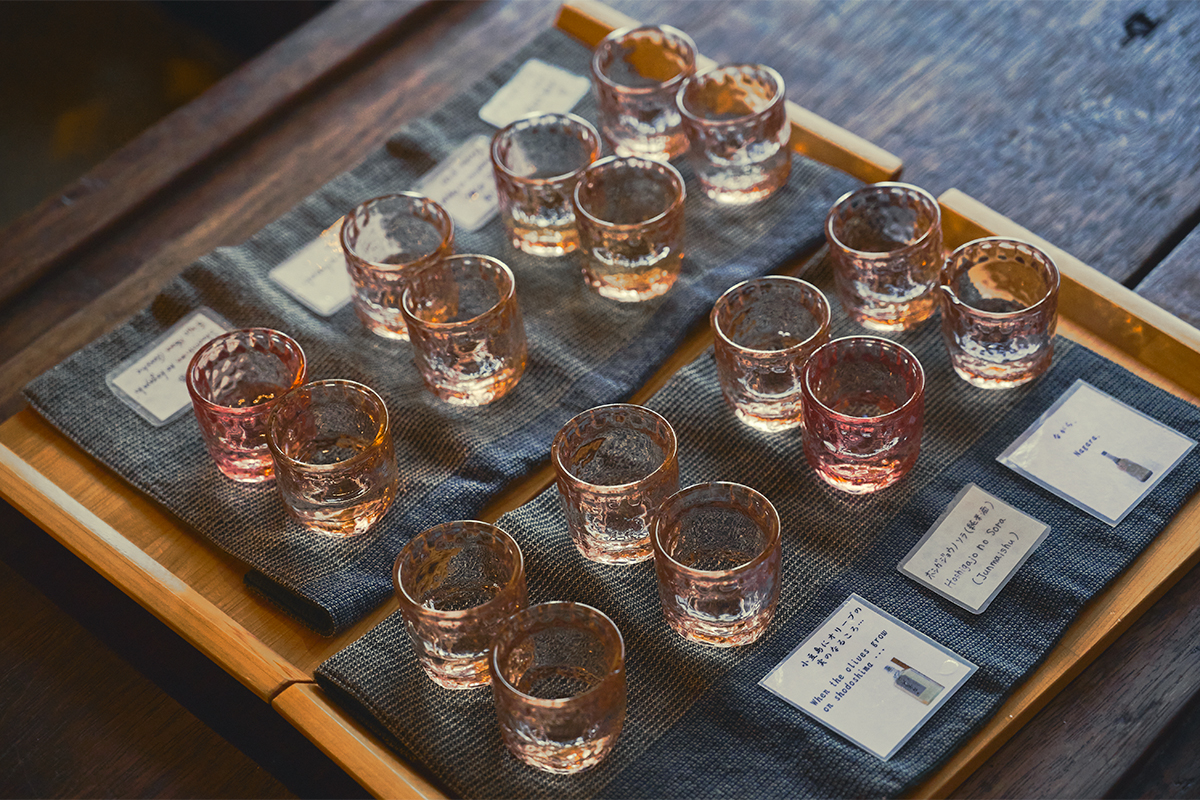 Visitors can sample various sakes—many return each year for this alone.
Visitors can sample various sakes—many return each year for this alone.
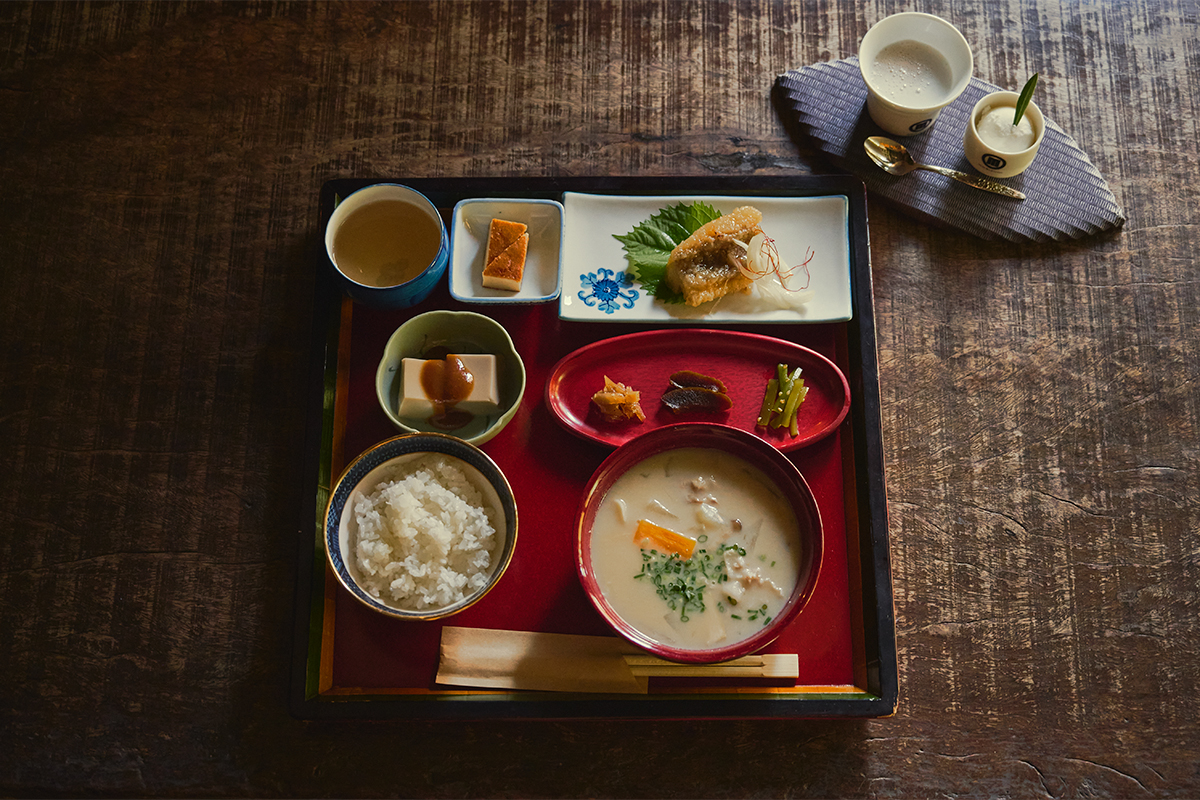 The premises also include a café and bakery. The café menu features hearty dishes made with sake-brewing by-products, such as ginjo lees soup and the Toji’s Staff Meal (1,700 yen; 2,200 yen for vegetarian or vegan options), as well as amazake smoothies (1,000 yen)—a delicious way to experience the blessings of fermentation.
The premises also include a café and bakery. The café menu features hearty dishes made with sake-brewing by-products, such as ginjo lees soup and the Toji’s Staff Meal (1,700 yen; 2,200 yen for vegetarian or vegan options), as well as amazake smoothies (1,000 yen)—a delicious way to experience the blessings of fermentation.
(Place visited)
Hashisakiya Honten
68-1-1 Shimogawara, Tatsuno-cho, Tatsuno City
9:00–18:00
Hakko Lab Coo
22-2 Shimogawara, Tatsuno-cho, Tatsuno City, Hyogo
TEL: 090-4292-5917
Hours: 10:00–17:00
Closed: Irregular
Workshop fee: 2,200 yen per person
Reservations: By phone or official LINE
Adachi Brewery (Direct Retail)
81-1 Nishiwaki, Kami-ku, Taka-cho, Taka District, Hyogo
TEL: 0120-35-1381
Hours: 9:00–17:30
Open daily
Instagram: @adachi_jozo
Yamaroku Shoyu
Marukin Soy Sauce Kinenkan
https://marukin.moritakk.com/kinenkan/
Shodoshima Shuzo MORIKUNI





